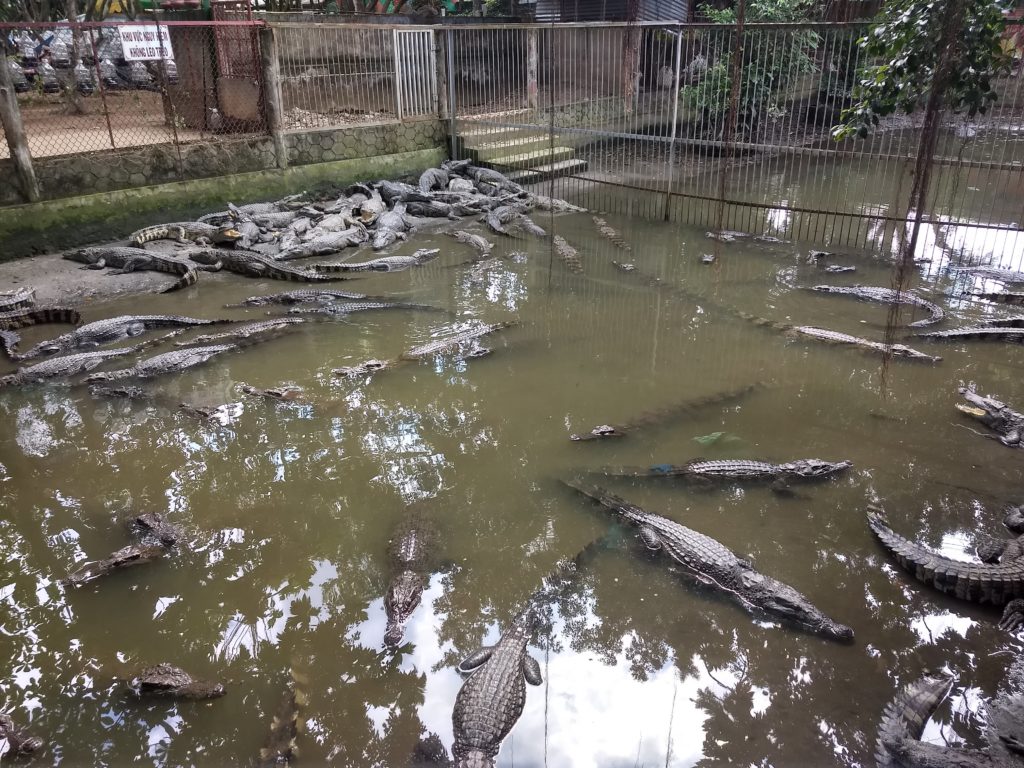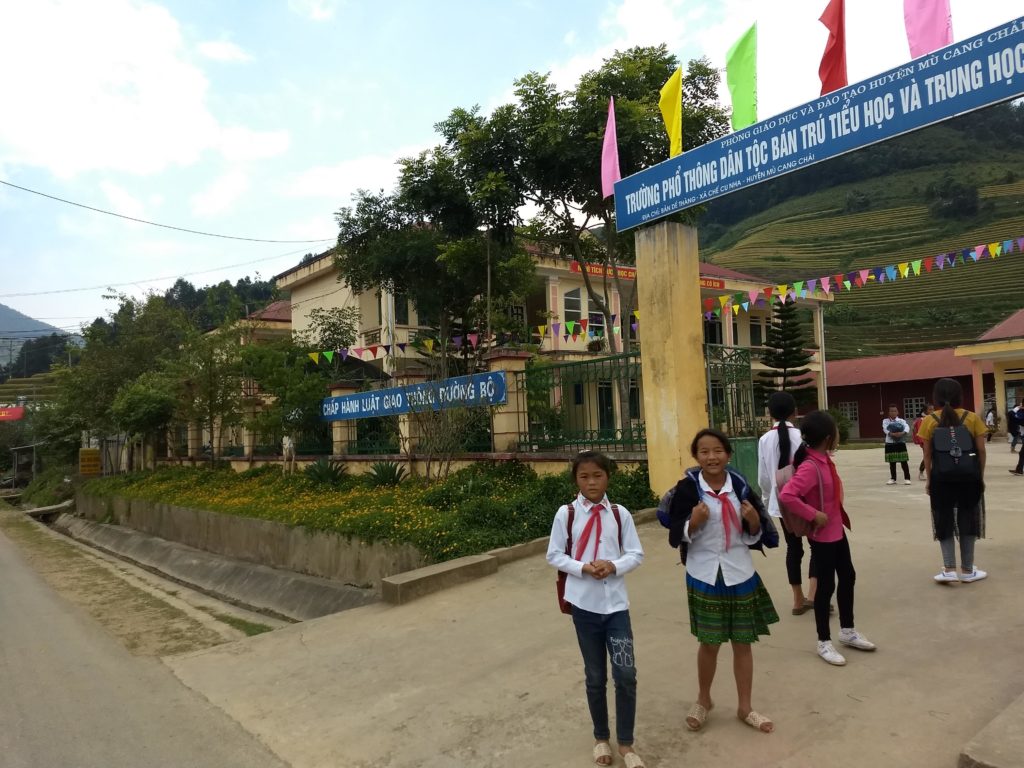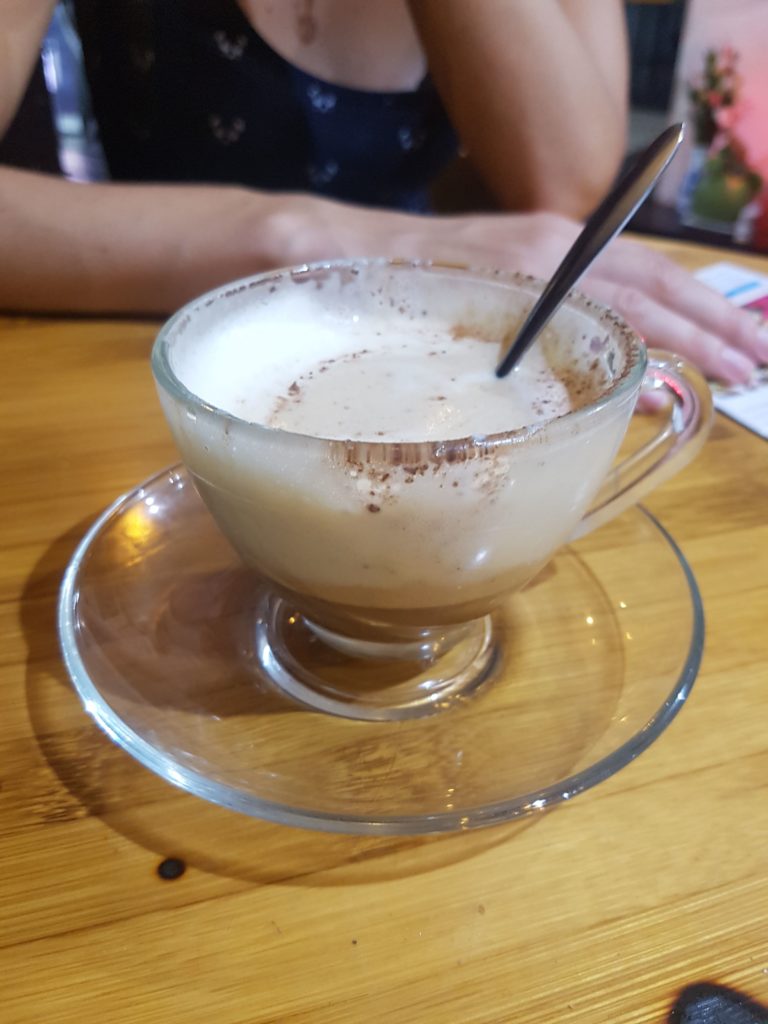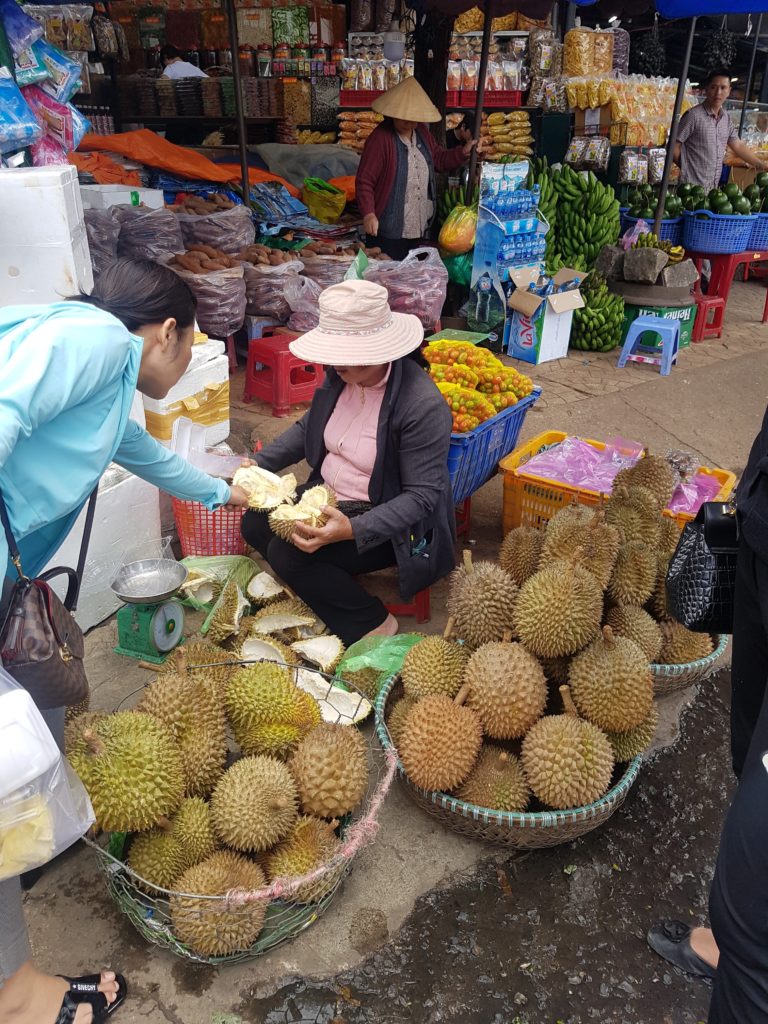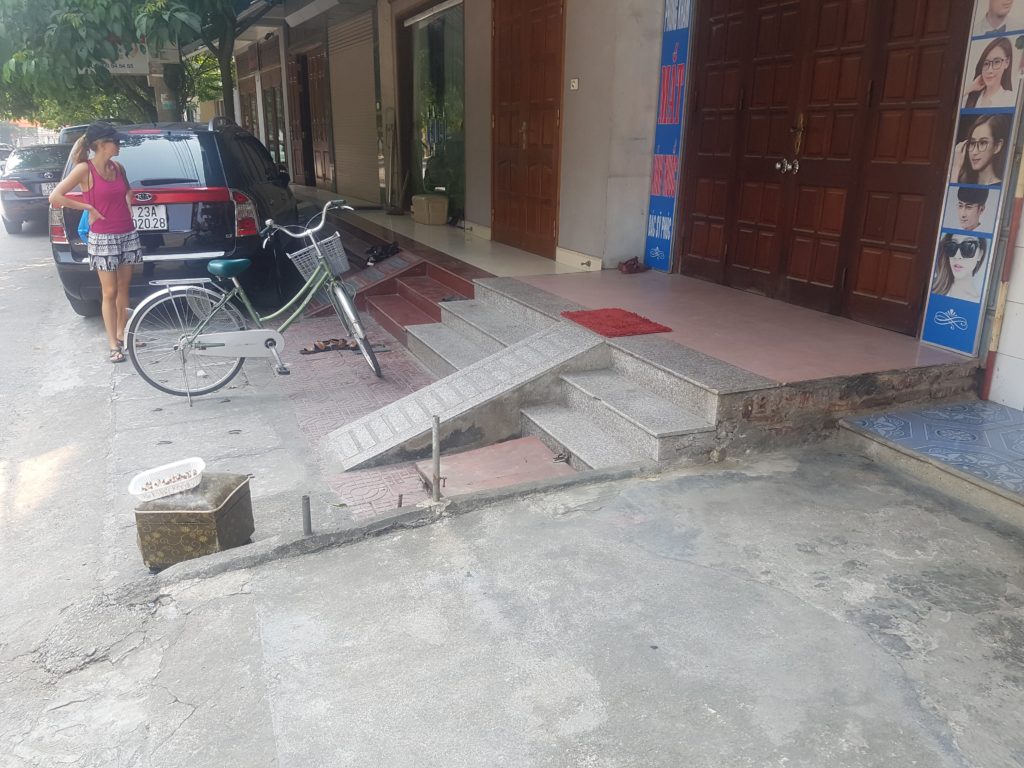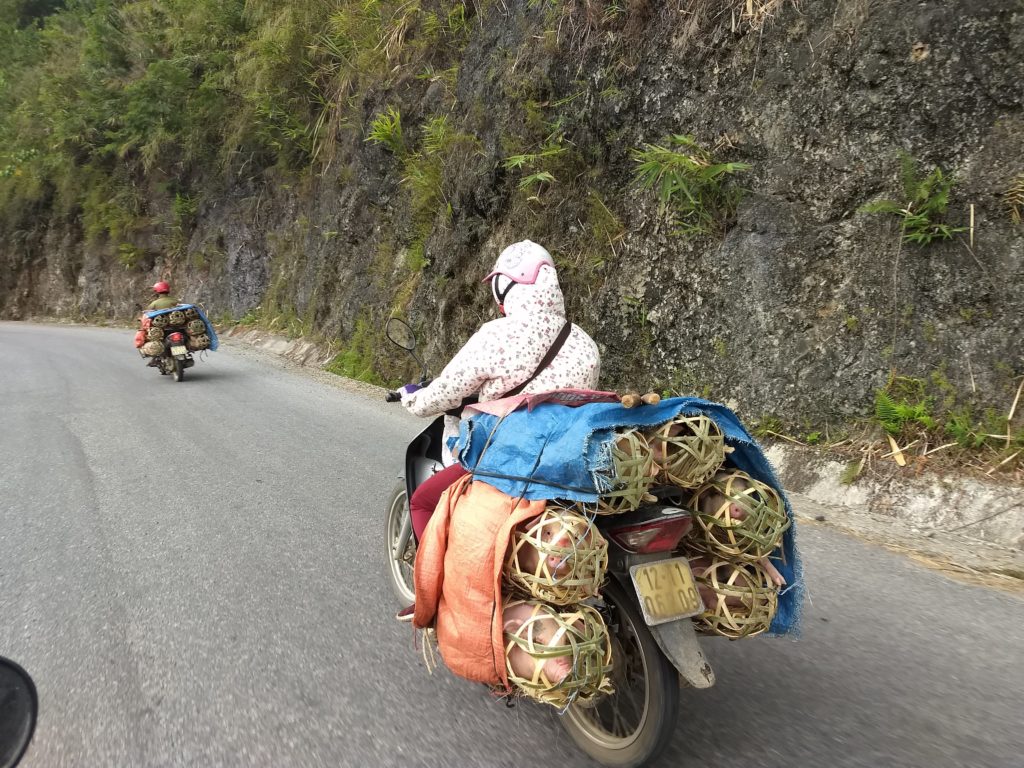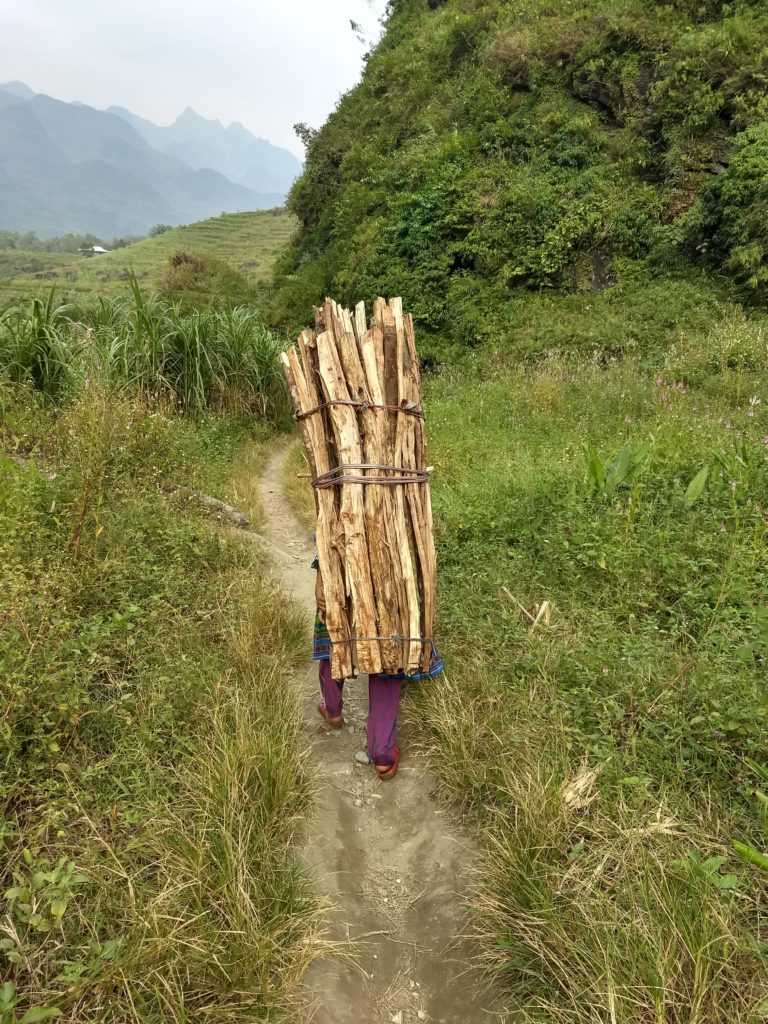High mountains and dense jungles, rice fields, and poor people living their simple lives. Ancient cities, Buddhist temples, as well as ubiquitous motorcycles, modern metropolises, luxury cars, and massive modern structures. All of this is Vietnam, a land of contrasts.
Vietnam is a very traveler-friendly destination. Even a beginner traveler can easily explore the beauties of this country because it’s safe (except for traffic), very affordable, and transportation is easy. The country is extremely welcoming to backpackers (cheap hostels and food can be found almost everywhere). You can afford adventurous exploration of the country, even in non-touristic areas, without worry. Vietnam is highly diverse, perfect for traveling, exploring, and active holidays; it certainly has a lot to offer. So, it would be a waste to stay in just one place (e.g., Danang by the beach). Plan at least 3 weeks for a visit to this country as Vietnam is large, and distances between interesting places are considerable.
Information before the trip
Vaccinations
Before traveling to Vietnam, it is advisable to get vaccinated. No vaccination is mandatory, but having basic travel vaccines is good: hepatitis A and B (hygiene is not at the highest level in Vietnam) and typhoid fever. Also, check the validity of the last dose of tetanus. You might also consider vaccination against rabies, although it is not essential. Dogs in Vietnam are not too aggressive, and there aren’t many monkeys. If you follow basic safety rules, nothing should happen. Remember that if you still decide to get vaccinated against rabies and get bitten, you’ll still need to go to the hospital for a booster shot. It’s advisable to consider vaccination at least six months before the trip to complete the whole process (several doses for hepatitis and rabies).
Visas
Unfortunately, Vietnam does not have a visa waiver agreement with the Czech Republic. So, before the trip, it’s necessary to arrange this and think about how long you want to stay in this country. There are several options: one-month, or three-month single-entry or multiple-entry visas. You can obtain a one-month single-entry visa online (E-visa) or upon arrival for $25. For a one-month three-entry visa, you’ll need to apply online at a Vietnamese agency for an approval letter, which you’ll bring with you to the airport and present to the officials to get the visa. The cost is $10-40 for the approval letter and $25 for the visa itself, payable at the airport in Vietnam. Multiple-entry visas for one or three months cost $50.
Transportation
Transportation in Vietnam is chaotic. To a European who has never experienced traffic in Asia, everything will seem confusing, very dangerous, and without any order or rules. But it’s not entirely like that. Although traffic seems chaotic, it has its order. People drive slowly, allowing them to adapt to the situation – brake, overtake, or bypass from all sides. Locals dare to drive in the opposite direction, even on highways, turn in the middle of the road, overtake in curves, turn without looking, and so on. Vietnamese don’t drive by the rules but by a sense and certain habits. Everyone must be constantly alert because something is always happening on the road. It’s unthinkable for someone to fall asleep out of sheer boredom behind the wheel. Other drivers, motorcycles, cattle, constantly crossing chickens, dogs, road holes, sudden changes in road surfaces, and local farmers drying whatever they need on the road – all of these things keep everyone alert. Once you get used to all this, you’ll move relatively well in this traffic. It’s important to honk so that everyone around knows about you and takes you into account.

Crossing the road is quite a challenge at first. You have to move slowly, steadily, and smoothly. Don’t expect anyone to stop for you (not even at most crosswalks), just carefully step onto the road and walk. You’ll surely find a small gap between the moving cars and motorcycles. If you signal that you are going and don’t abruptly stop, they will go around you. Local transportation also depends on trust. Trust that the motorcyclists see you from a distance and plan how to pass you.
Very often, you’ll hear all means of transportation honking. They honk for several reasons: when overtaking, when turning, driving in the opposite direction, when they don’t like something, while entering a curve, when greeting, taxi – to signal they are available. If you are driving, you also need to honk so everyone knows you’re coming.
Train
Traveling by train is undemanding but not very comfortable. You can buy a ticket for one of the three classes, where you might find wooden seats or soft sleeper cars. Neither option is ideal. Trains move slowly, don’t go everywhere, aren’t too comfortable, or are expensive. There are also very luxurious trains here, but the price is disproportionate.
Taxi and GRAB
For short-distance transportation, you can use local taxi services, which, compared to Europe, aren’t as expensive. However, expect negotiations and haggling over the price.
The second option is to use the GRAB service. Through the mobile app, you can order a motorcycle, car, or other means, and immediately see the price in the app. This service is about 40-50% cheaper than regular taxis. You don’t negotiate the price further; you pay what the app shows. You have the assurance that the price is fair, and you don’t have to negotiate with anyone.
Bus
Probably the most widespread means of mass transportation, whether for short or long distances, is the bus. You can use standard seated buses or sleeper buses, which are a common sight here despite being banned in Europe.
For longer distances, buses are an inexpensive means of transport. In the evening, you lie down in the bus bed, and in the morning, you wake up at your destination. The speed is approximately 50 km/h. For instance, the trip from Hanoi to Hue is about 670 km and takes around 14 hours. It depends on the carrier. Since various companies provide transport, you can choose. They may differ in price, quality, pickup and drop-off locations, and travel time. It’s worthwhile to find out beforehand. The travel time is approximate, depending on traffic, the number of passengers boarding along the way, the number of stops, etc. The advantage of these sleeper buses is that they run at night, so you don’t lose a day traveling and also save on accommodation.

Upon entering any bus, you must take off your shoes, which they’ll place in a bag for you. You’ll also receive a blanket, which is handy at night. Sometimes, they prepare a box with slippers at stops so you don’t need to take your shoes when going to the toilet or to the buffet. Most buses also have WiFi. Higher-quality buses have curtains, USB plugs, a TV, and you’ll even receive water. Headphones or some entertainment might be useful for the journey.
City buses are an inexpensive way to travel within the city. The journey takes a long time, but it costs a few coins (7,000 VND in Hanoi, excluding routes to and from the airport, 5,000 VND in Saigon). The price is uniform regardless of your destination. Finding a stop or a specific bus can be more complicated. Google Maps, which usually shows the right place and often the bus number or platform, is very helpful.
Motorbike
The motorbike is the most commonly used means of transportation in Vietnam. You wouldn’t believe what all can be transported on a motorbike—from a family (2 adults and 3 children) to pigs, goats, chickens, bags of rice, cement, etc. Vietnamese even transform their motorcycles into cargo bikes to carry bricks for a new house, for example. They can easily convert a motorbike into a mobile store or buffet. They even attach homemade trailers to motorcycles for carrying loads. It’s because of these reasons that riding a motorcycle at night in Vietnam is dangerous. Many motorcycles lack lights, drive in the opposite direction, or are unexpectedly loaded with everything possible. They shine like motorcycles, but their vehicle dimensions are more like a car.
Driving in cities is a trial even for experienced riders. Motorbikes go in all directions, and traffic is very dense. If you can, avoid driving in Hanoi and Saigon, at least minimally.

Renting a motorbike:
There are parts of Vietnam where you can’t manage without this means of transportation. In tourist towns, you can rent a scooter or semi-automatic motorbike, which is a great way to explore the surroundings. Prices are around 150,000 VND per day if you return it to the same place. If not, you’ll pay around 350,000 VND for a one-way trip with the assurance that your luggage will be delivered to your destination. Servicing and all bike repairs are usually covered by the company that rents you the motorbike (except for punctured tires).
If you decide to tour a larger area on a motorbike, such as the mountains in the north, you can rent a motorbike for a longer period (like a month). Prices vary among different companies. You can rent a bike like this in Hanoi or directly in the mountains in Ha Giang (thus avoiding the traffic in Hanoi).
Buying a motorbike:
A process that requires thought. Buying a motorbike is usually done in large cities. You have to consider whether it’s worth buying when you’ll have to sell it again in the end. Expect a loss in value and that it will take some time and bargaining. If you buy a bike from a local seller, they will always try to get as much as possible from you. The machine will work but usually only for demonstration; your investment begins afterward. Local bike dealers buy bikes from tourists, for example, for $100 and immediately sell them to other tourists for $200. But there are exceptions, of course. Buying from a traveler might be a better solution. They can at least tell you some information about the bike since they’ve spent some time with it and have probably repaired it several times. Cheap doesn’t always mean bad, and vice versa. It needs to be tested.

Before buying, check:
- If you receive a blue card (documents for the motorcycle).
- If there’s no oil leaking from the engine (engine oil).
- How it starts (Does it catch immediately, or does it take time? If it has minor starting issues, it might eventually stop starting altogether, and you’ll end up in the service).
- If it can idle and not stall.
- If possible, have a look at the spark plug to see if it’s not black between the poles (it needs unscrewing – a simple and inexpensive procedure).
- Put the motorcycle on a stand and spin the front wheel; it must not wobble (the wheel must rotate straight); otherwise, it’s usually damaged.
- Try pushing the handlebars with full force. You should feel resistance, and it should return you, otherwise, the shock absorbers are bad. Rear shock absorbers need to be checked as well.
- It’s also important to check the lights (front, rear, and don’t forget the brake light). If the lights don’t work, it may not just be a broken bulb but a more extensive repair. Mountain roads are not lit, and you can’t do without lights here.
- The horn must also work perfectly. When a truck starts pushing you off the road, it’s the only way to make your presence known.
- Take it for a ride, try all the gears and rev it up, it shouldn’t jerk or stall.
- You can also check if the tachometer works, but that’s not very crucial in Vietnam. You can’t drive too fast here.
All of these are small repair amounts, but they can add up and haunt you. If you have enough time and get the machine for a very low price, everything can be repaired. Local services (Xe May) are well-equipped and can be found even in the most remote mountain villages. You can recognize them easily by the sign or by their appearance – a very dirty garage at someone’s home full of everything needed for repairs.
The purchase itself is a straightforward process. You pay and get the keys and the blue card. There’s no motorcycle transfer waiting for you, no running around offices, and no insurance to worry about. The motorcycle is still registered to a Vietnamese person but changes owners frequently.
Police
If you’re riding a motorcycle in Vietnam, you’re likely doing it illegally. Vietnamese police only recognize a Vietnamese driver’s license, which is not easy for foreigners to obtain. Most people opt for an international driver’s license + bribes. Officially, the international driver’s license should be recognized since 2015, but rights won’t help you here; the police won’t easily give up thick bribes. They will always find something to fine you for. Often, they ask for money for driving without a license, speeding, or any other invented violation. They demand amounts in the range of several million VND. You can avoid this if you tell them that by law, they must recognize the international driver’s license and that they have no proof of the offense. However, it depends on whom you encounter.
If you don’t want to argue with them, just keep 100-200 thousand VND in your pocket and show that you have no more. They’ll take it and let you go. Another way to get rid of the police is to pretend you don’t speak English. After a while, they might give up and let you go. It’s also recommended not to stop at all and just run if the police don’t start chasing you. In case they do stop you, it’s essential to immediately take the key out of the ignition and put it in your pocket before they do.
It’s also not recommended to hand over your passport or driver’s license to the police because they might only return it after paying an unreasonably high fine. Some police officers specifically target foreigners for money, while others ignore them to avoid trouble and arguments (not everyone speaks English). There are quite a few police patrols in Vietnam. They are visible almost everywhere, even in remote mountain villages where you wouldn’t expect them.
Airplane
If you’re traveling long distances, don’t want to take a bus, and want to save time, you can fly. It’s a fast way of transportation; the journey takes a few tens of minutes to an hour, and you can reach relatively smaller cities like Da Lat or Hue. There are three international airports in Vietnam (Hanoi, Ho Chi Minh, and Da Nang) and many small domestic ones. Several Vietnamese low-cost airlines operate connections between cities.
Food
Food in Vietnam is diverse and specific to different regions. The base is rice and rice noodles, vegetables, and meat. In the north, you’ll find very simple dishes like Pho soup, which serves as the main course. In villages, you usually don’t choose food – they have only one. In cities, however, you’ll find many types of dishes and can also enjoy a variety of street food, especially in Hanoi. Be prepared that local portions are small by European standards but inexpensive. Some of the most common dishes include:
- Pho – wide rice noodles; if you add the type of meat (Ga, Bo, Ca, Thit…), it becomes noodle soup. It’s different in the south than in the north. It’s usually with some type of meat, vegetables, herbs, sprouts. Lime and chili peppers are always on the table. Priced around 20-50 thousand VND.
- Bun
– rice vermicelli; also depends on the region and content (with fried spring rolls, grilled meat, seafood…). It’s cheaper than Pho. - Com – rice with something – grilled meat, eggs, etc. They usually serve it in a metal plate with different compartments for each dish.
- Banh Mi – Vietnamese sandwich baguette with different fillings – pate, ham, grilled meat, vegetables, and various sauces. It’s sold on every corner, even in small villages.
- Goi Cuon – spring rolls made of rice paper filled with vermicelli, shrimp, pork, herbs, and served with peanut sauce. It’s light and served cold.
- Banh Xeo – Vietnamese pancake; it’s a rice flour pancake filled with shrimp, pork, and bean sprouts. You wrap it in lettuce leaves and dip it in fish sauce.
- Pho Cuon – a roll made of Pho soup ingredients wrapped in rice paper.
- Chao – rice porridge served with fish, meat, or doughnuts.
The sacred lake that extends into the old quarter is perhaps the most famous lake in Hanoi. In the middle of the lake, there’s a small island with the Turtle Tower. The tomb on the island is dedicated to a giant turtle that, according to legends, had a historical influence on the city by gifting a sword to a king that helped win a war. The man who had this tomb built has his statue on the eastern shore of the lake (Statue of King Ly Thai To). At this monument (on the right when facing the statue), you can fill your own bottles with free drinking water. Additionally, in the middle of the lake on the island, there’s a small temple dedicated to the aforementioned turtle (Temple of the Jade Mountain). Admission fee is required to enter the temple, but locals are striving to make it free in the future, so you might get lucky. Let us know in the comments if there have been any changes.
The lake and its surroundings come alive on weekend evenings when motorbikes and cars are not allowed around the lake, creating a safe space for people to stroll. There’s activity from the early morning hours, with people dancing, exercising, playing, kids driving electric cars (remote-controlled by their dads), or simply walking around and conversing. It’s a place for gatherings and weekend leisure. Tourists are often stopped with the phrase “Hello, do you speak English?” These are children and adults who simply want to practice their English. You can engage in conversation with them at your leisure. You’ll see groups of people exercising or dancing in many places around the lake and other parks in Hanoi. It’s quite popular—someone who knows how to dance brings a speaker to the park, plays music, and does a demonstration. Passersby can join in as they wish. It looks very spontaneous and friendly.
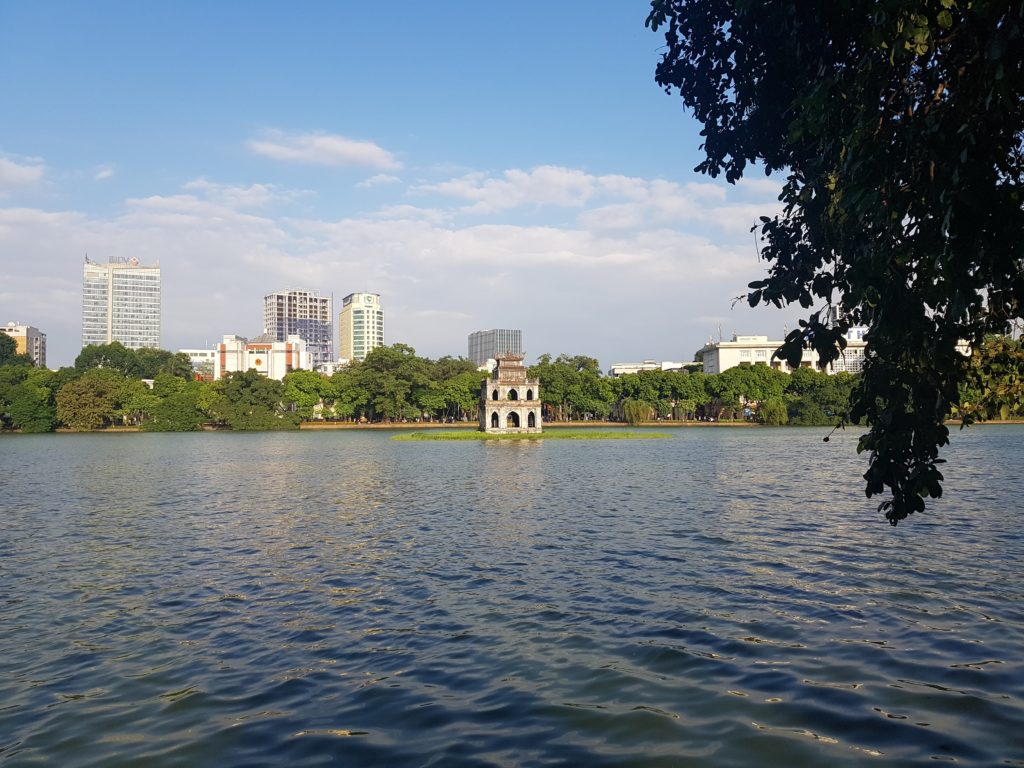
Ho Chi Minh Mausoleum
The mausoleum, as the name suggests, is the resting place of the embalmed body of the national hero and former ruler Ho Chi Minh. In this complex of buildings, you can visit the tomb for free, but beware of the opening hours – it’s essential to verify as they are very short. For a modest fee, you can visit his house, the presidential palace, and his workplace. Furthermore, there’s a museum celebrating Ho Chi Minh himself, and entry requires a fee. To enter the complex, it’s necessary to cover your shoulders and knees.
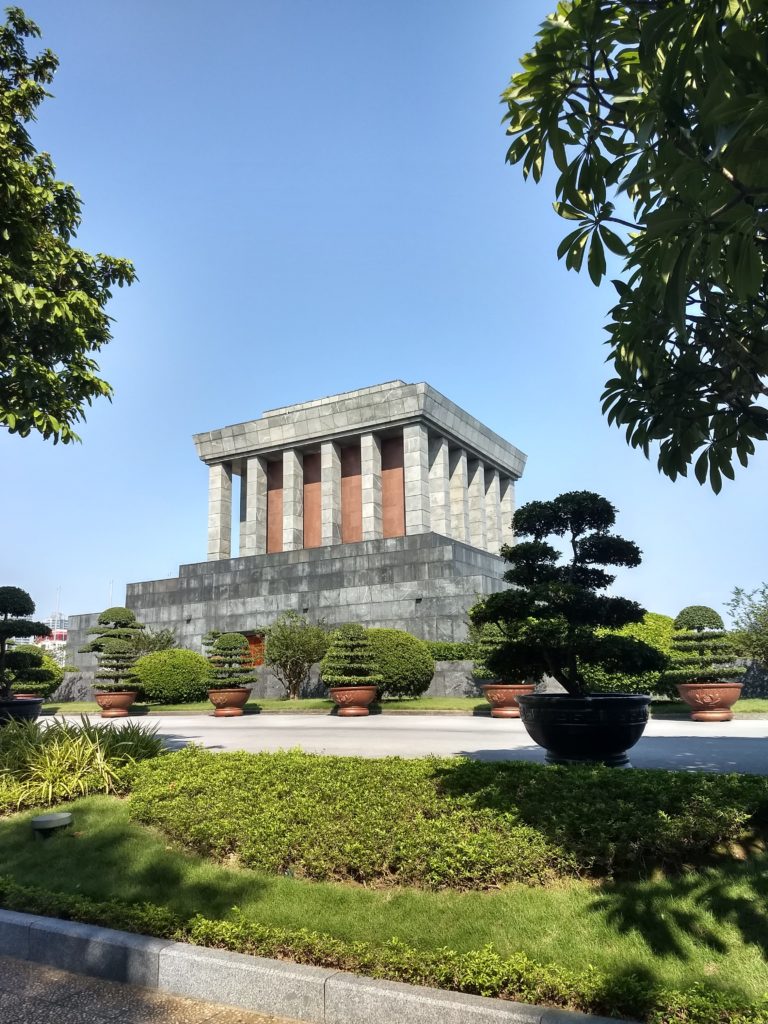


Literature Temple (Van Mieu)
Van Mieu is a temple dedicated to Confucius. It’s located near the Old Quarter and showcases beautiful traditional architecture. The grounds are home to the Stele of Doctors, a large stone turtle, and the Well of Heavenly Clarity. You’ll find a peaceful and serene atmosphere here, a stark contrast to the busy streets nearby. The entrance fee is very affordable.
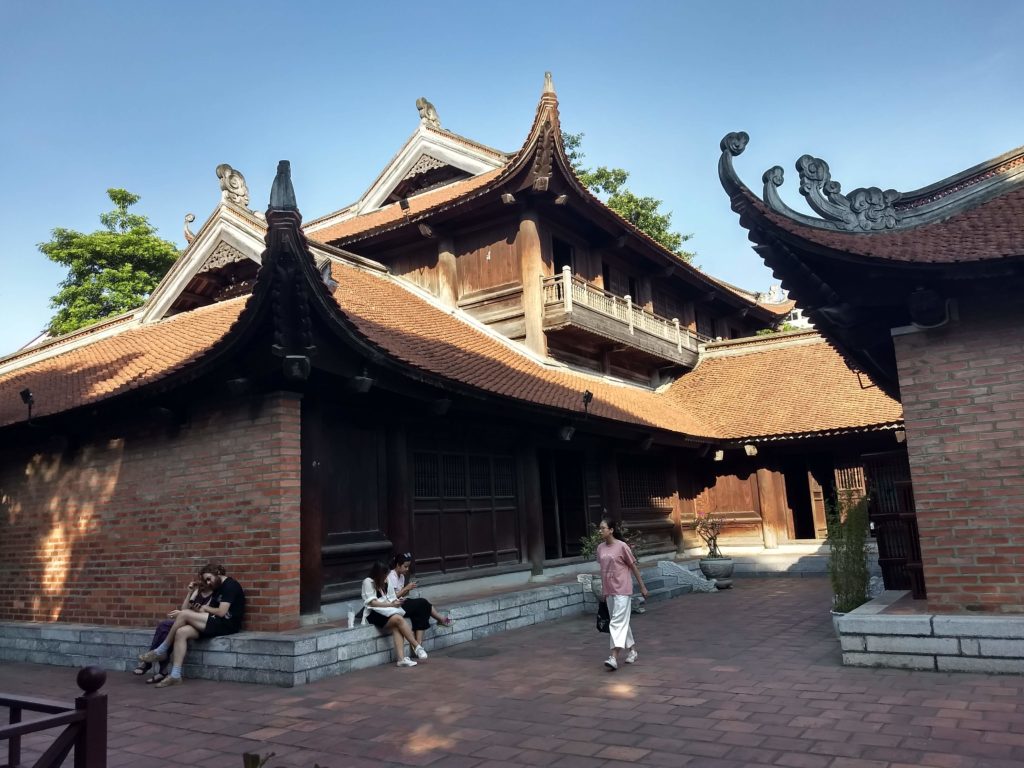

The sacred lake that extends into the old quarter is perhaps the most famous lake in Hanoi. In the middle of the lake, there’s a small island with the Turtle Tower. The tomb on the island is dedicated to a giant turtle that, according to legends, had a historical influence on the city by gifting a sword to a king that helped win a war. The man who had this tomb built has his statue on the eastern shore of the lake (Statue of King Ly Thai To). At this monument (on the right when facing the statue), you can fill your own bottles with free drinking water. Additionally, in the middle of the lake on the island, there’s a small temple dedicated to the aforementioned turtle (Temple of the Jade Mountain). Admission fee is required to enter the temple, but locals are striving to make it free in the future, so you might get lucky. Let us know in the comments if there have been any changes.
The lake and its surroundings come alive on weekend evenings when motorbikes and cars are not allowed around the lake, creating a safe space for people to stroll. There’s activity from the early morning hours, with people dancing, exercising, playing, kids driving electric cars (remote-controlled by their dads), or simply walking around and conversing. It’s a place for gatherings and weekend leisure. Tourists are often stopped with the phrase “Hello, do you speak English?” These are children and adults who simply want to practice their English. You can engage in conversation with them at your leisure. You’ll see groups of people exercising or dancing in many places around the lake and other parks in Hanoi. It’s quite popular—someone who knows how to dance brings a speaker to the park, plays music, and does a demonstration. Passersby can join in as they wish. It looks very spontaneous and friendly.



Ho Chi Minh Mausoleum
The mausoleum, as the name suggests, is the resting place of the embalmed body of the national hero and former ruler Ho Chi Minh. In this complex of buildings, you can visit the tomb for free, but beware of the opening hours – it’s essential to verify as they are very short. For a modest fee, you can visit his house, the presidential palace, and his workplace. Furthermore, there’s a museum celebrating Ho Chi Minh himself, and entry requires a fee. To enter the complex, it’s necessary to cover your shoulders and knees.



Ho Tay Lake
One of the largest lakes in Hanoi. You can take a walk around here; there are several parks, interesting temples, and pagodas. One of them is the remarkable Tay Ho Pagoda.
Nuoc Nham Ha Noi Bus Station – Ben xe Nuoc nham Ha Noi
If you plan to travel between cities by bus, knowing this place is necessary. It’s the main bus station from which almost all types of buses depart. You can reach here from the city center by city bus (terminal). On the first floor of the building, you can purchase tickets from one of the companies. It feels a bit like a marketplace. People behind the counters will aggressively try to get you to choose their window. After selecting a window, inquire about the destination, and they’ll immediately tell you the price and whether their company operates on that route. The price is negotiable, even if it’s written. Make sure to find out where the bus will drop you off. Some buses from Hanoi to Saigon, for example, may drop you off at the highway instead of going into the city. After getting off, you might find yourself several, if not dozens, of kilometers away from where you needed to be. Taxi drivers often take advantage of this, waiting for you and aggressively offering their services. The question is how much you can foresee this in advance.
After purchasing the ticket, you’ll go through a ticket check to the bus parking area, where you can’t buy anything else, with no chance of returning. It’s recommended to buy enough food and water beforehand. During the bus journey, there are occasional stops at toilets and restaurants. Buses may not always run on time; sometimes, they wait seemingly without reason for an hour or two.
Sapa
If you want to head to the mountains, one of the easiest ways is to reach the famous Sapa. Direct buses run here from Hanoi and other parts of the country. You can either get there by bus or opt for an organized tour. But if you’re seeking the true Vietnam, you won’t quite find it here. Sapa and its surroundings are more like a theater designed for tourists. Sapa itself resembles a modern city rather than a poor village in the mountains. You’ll find plenty of luxury restaurants, huge hotels, lots of souvenirs, shops with imitation brand clothing, and a paid view of the city. The main attraction of the town is undoubtedly Fansipan. With its height of 3143 meters above sea level, it’s the highest mountain in Vietnam and the entire Indochina region.
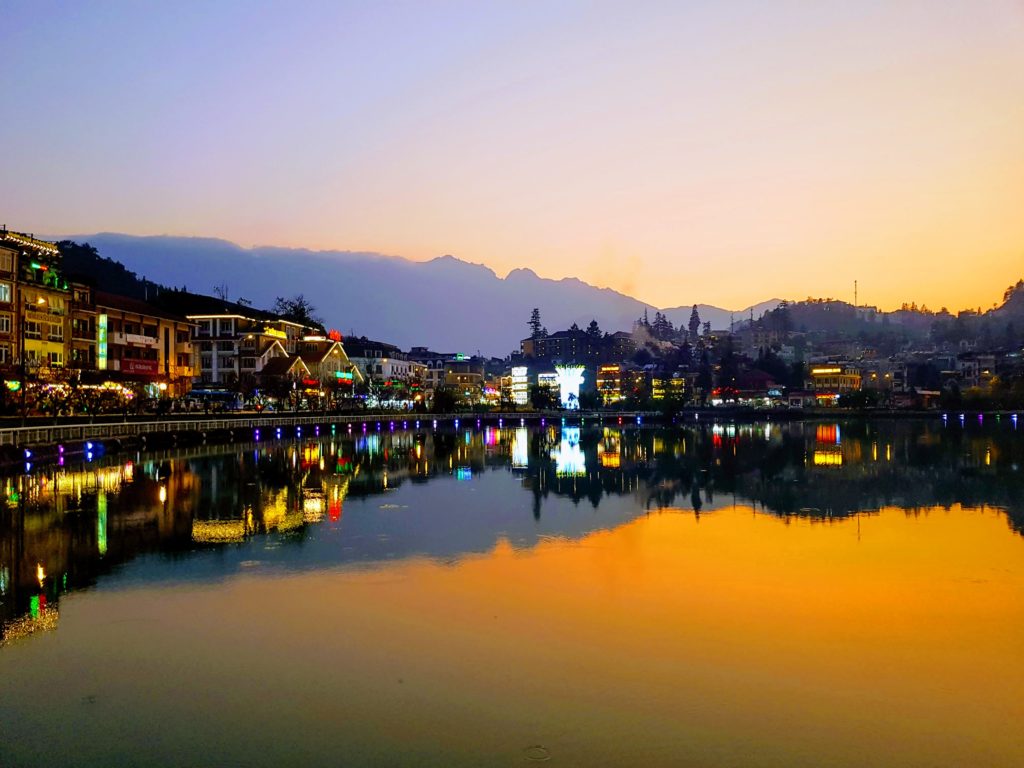

Fansipan
You can reach the summit either on foot or by cable car. Directly from Sapa, you can take a train for 80,000 VND one way or 160,000 VND round trip. The price includes a small bottle of water. The journey takes about 20 minutes, and the train will stop at the next station, from where you can either walk or take the cable car. The ticket price to the top by cable car is 700,000 VND, and the return ticket is 800,000 VND. If you choose to hike, it might take you a few days. The views along the way are incredible. Make sure to bring enough food and water, as there are no shops or stalls selling anything until you reach the top. Once you’re at the summit, you can buy a lot of souvenirs or eat a small meal. The price is, as expected, higher than in Sapa.
Bac Ha, Ha Giang, and Du Gia
If you want to experience a true Vietnamese adventure, visit these places. They are not as touristy as Sapa and offer a more authentic experience of the country. You can go trekking, visit minority villages, and explore the stunning landscapes of northern Vietnam. It’s recommended to join a guided tour or hire a local guide because the area can be challenging to navigate on your own.
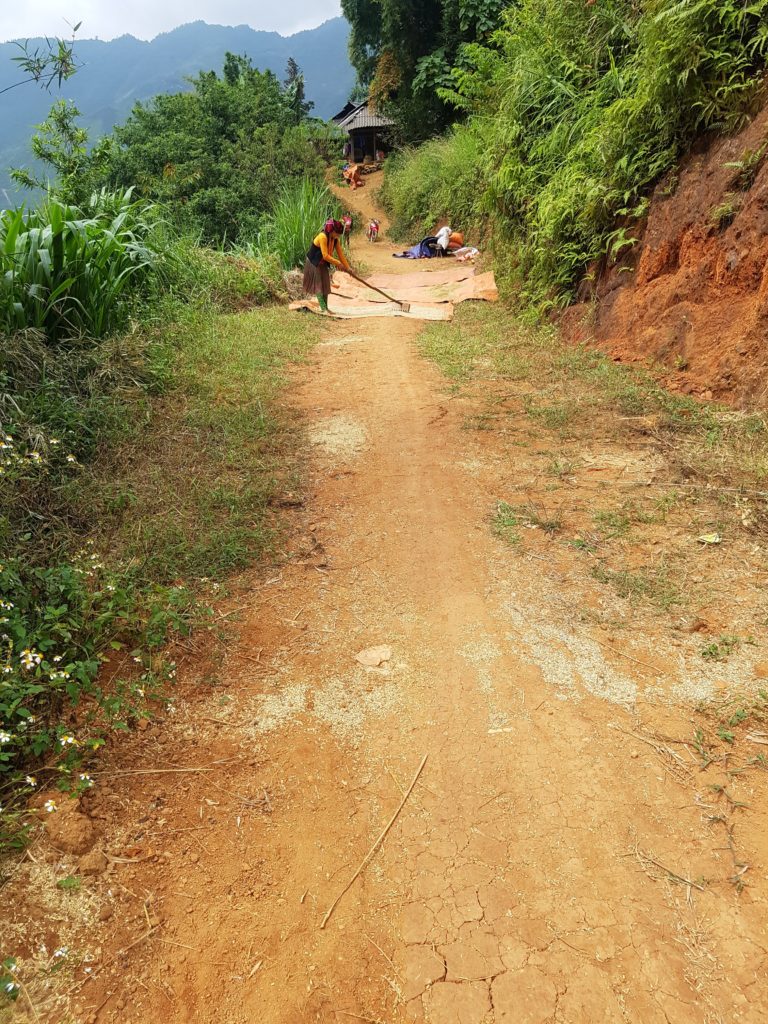

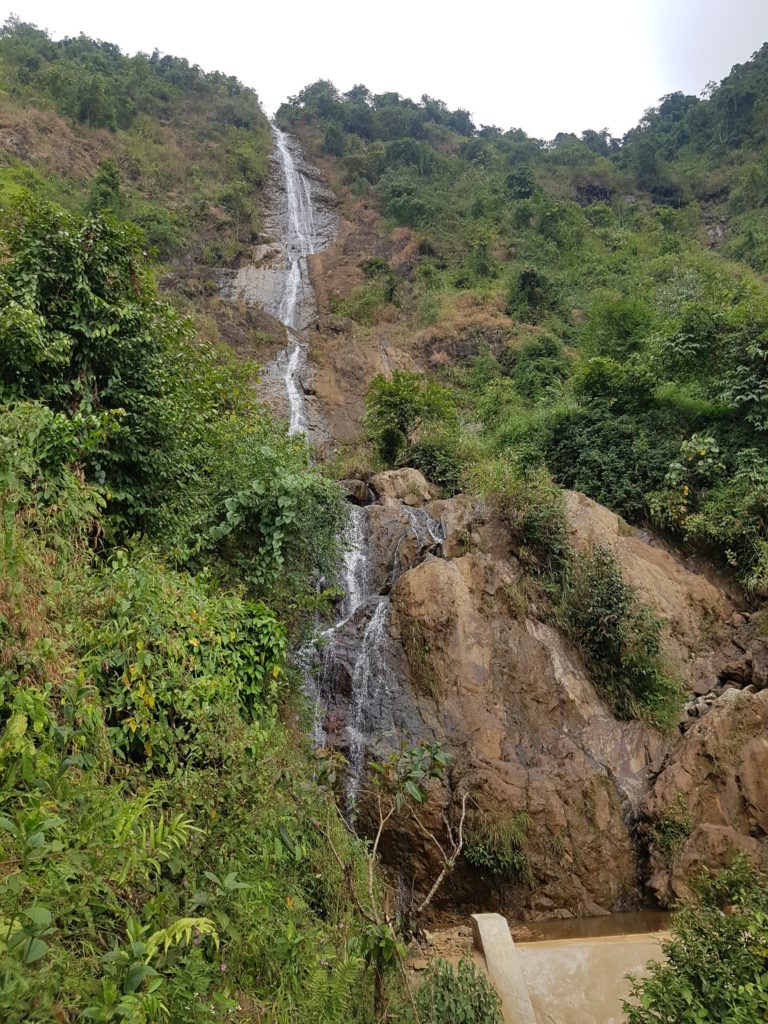

In the town of Na Phong, you have the option to leave the loop and continue east towards Bao Lac. In this area, you won’t find many restaurants or accommodation options, and you’ll encounter few tourists. You’ll have the chance to experience traditional Vietnam peacefully, without many tourists.
Cao Bang
This area in northeastern Vietnam (on the border with China) is definitely worth a visit. It’s quite a distance from Sapa and Ha Giang, and most tourists don’t make it here. You might encounter Vietnamese tourists from Hanoi or Saigon who came for a weekend trip. Here, you can see beautiful rice fields dotted with conical hills, Buddhist temples, and waterfalls.
The main attraction in this area is the Ban Gioc waterfall, located about 80 km northeast of the town of Cao Bang right on the border with China. It’s the largest waterfall in Vietnam. There’s a small entrance fee to see the waterfall, and inside the area, you can pay for a small boat to take you right under the waterfall. However, this isn’t necessary as the waterfall is easily visible from the shore. The same happens on the opposite bank in China, so Chinese and Vietnamese boats alternate under the waterfall. The waterfall is mighty, so swimming in it is prohibited, but along the shore, you can at least step into the water up to your knees.
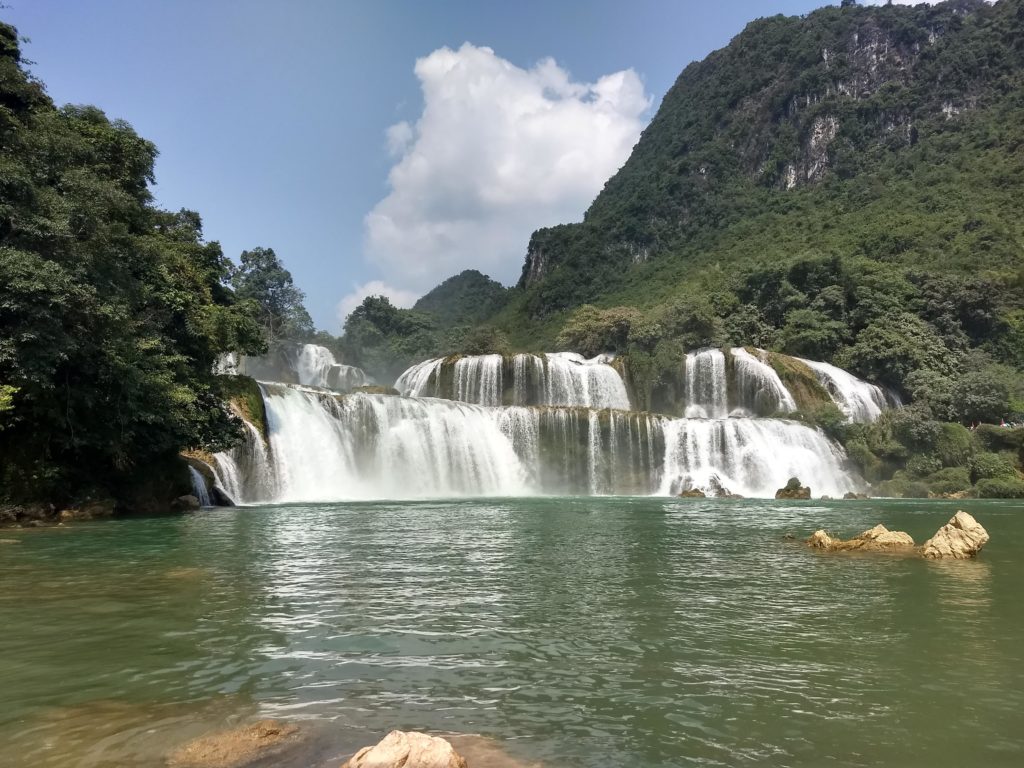

On the way to the waterfall, you can stop at the Ngam Ngao karst mountains, located near the town of Trung Khanh. They’re not as impressive as Ha Long Bay, but it’s a nice stop if you’re in the area.
There’s also the Pac Bo cave, located 50 km north of Cao Bang, where Hồ Chí Minh lived and worked when he returned to Vietnam after spending many years abroad. Inside, there’s a small museum and the opportunity to hike to a nearby waterfall.
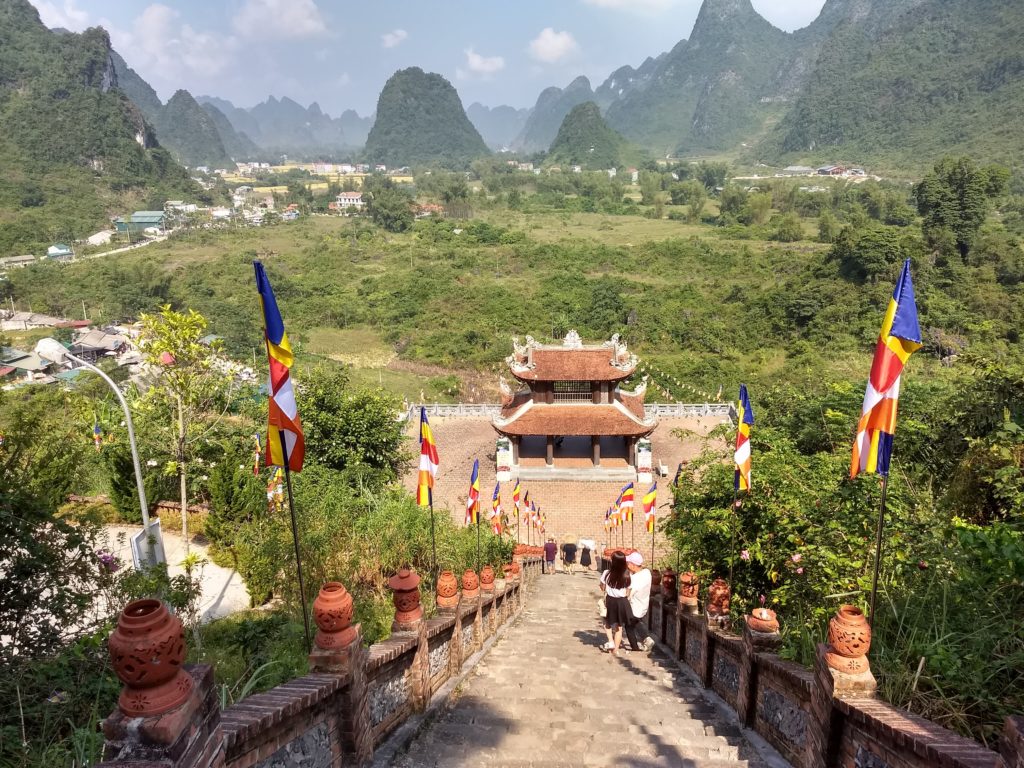

In this area, the stalactite cave Dong Nguom Ngao (also known as the Tiger Cave) is worth a visit, not far from the waterfall (about 4 km). There’s an entrance fee to the cave, and you can explore it without a guide. The cave is relatively large, and some stalactites reach enormous sizes. Unfortunately, there aren’t many rules in place to protect the stalactites. People touch and climb on them without realizing they’re damaging them. The main feature of the cave is a stalactite in the shape of a lotus flower. You don’t need warm clothing in the cave; it’s not as cold as stalactite caves in Europe.
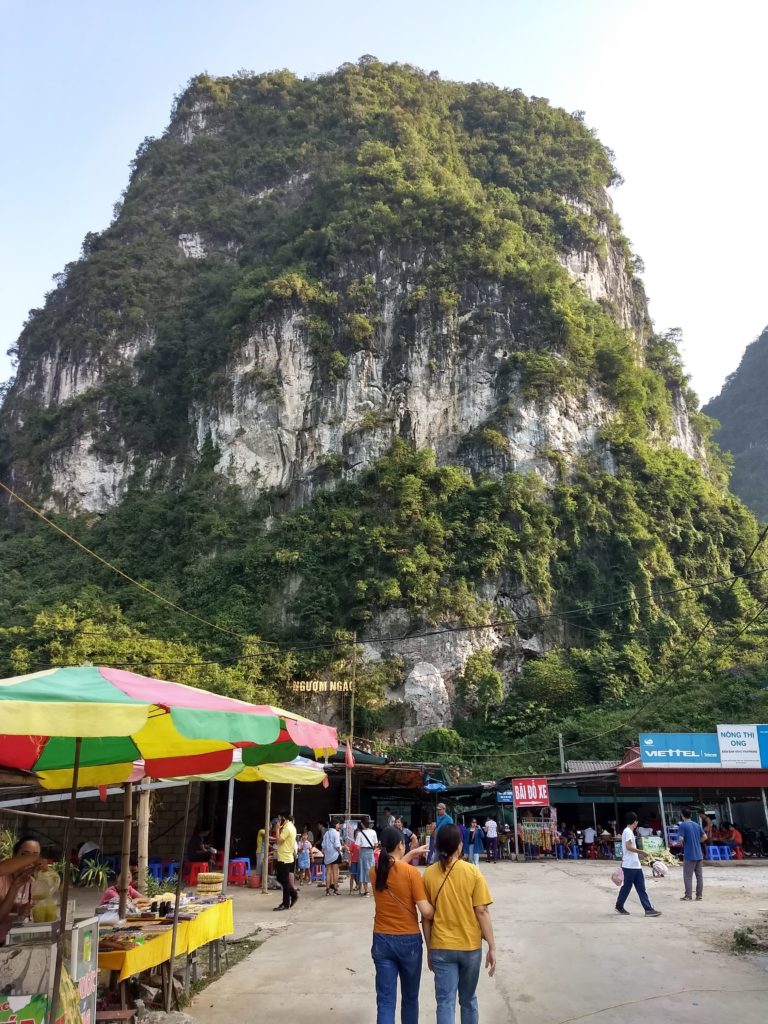



You can stay near these interesting places in one of the authentic homestays. Don’t expect any luxury; usually, it’s just a mattress on the floor. For an extra fee, you can experience a traditional Vietnamese dinner with the family.
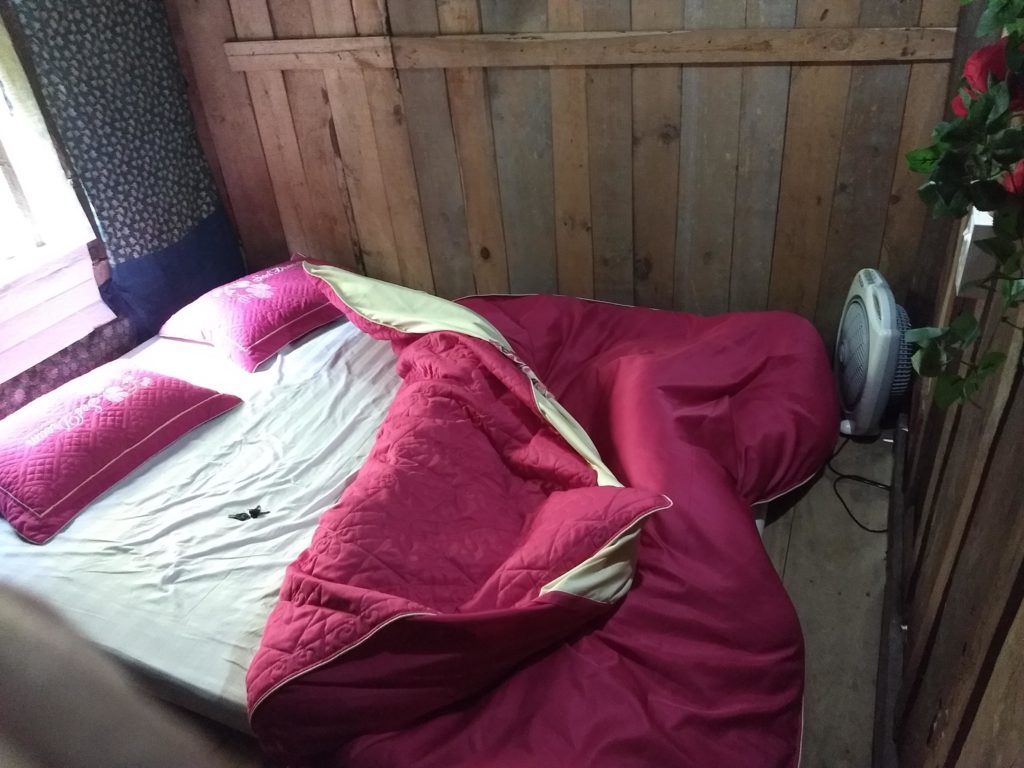

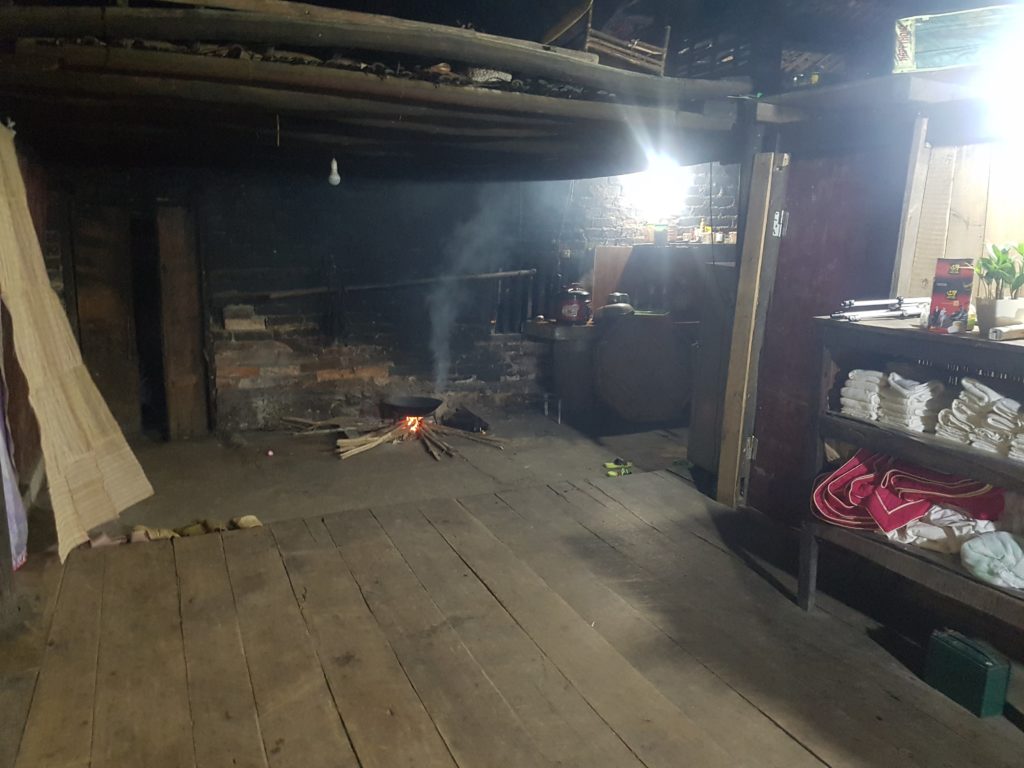

If you’re heading further south on a motorcycle, another stop on the way could be Lang Son, where you can easily find accommodation and food. Lang Son is a relatively large and confusing city. It’s not touristy, but there are nice places to visit. For example, small pointed hills on the edge of the city. People gather here in the evenings or mornings to exercise, climb stairs, or just sit and chat. You’ll get a view of the whole city and its surroundings. Further, right in the city center, you’ll find two pointed rock formations accessible by stairs. Here, you can again see the city, even at night. Everything is nicely lit, and admission is free.
From this city, you can continue to Ha Long (approximately 160 km).
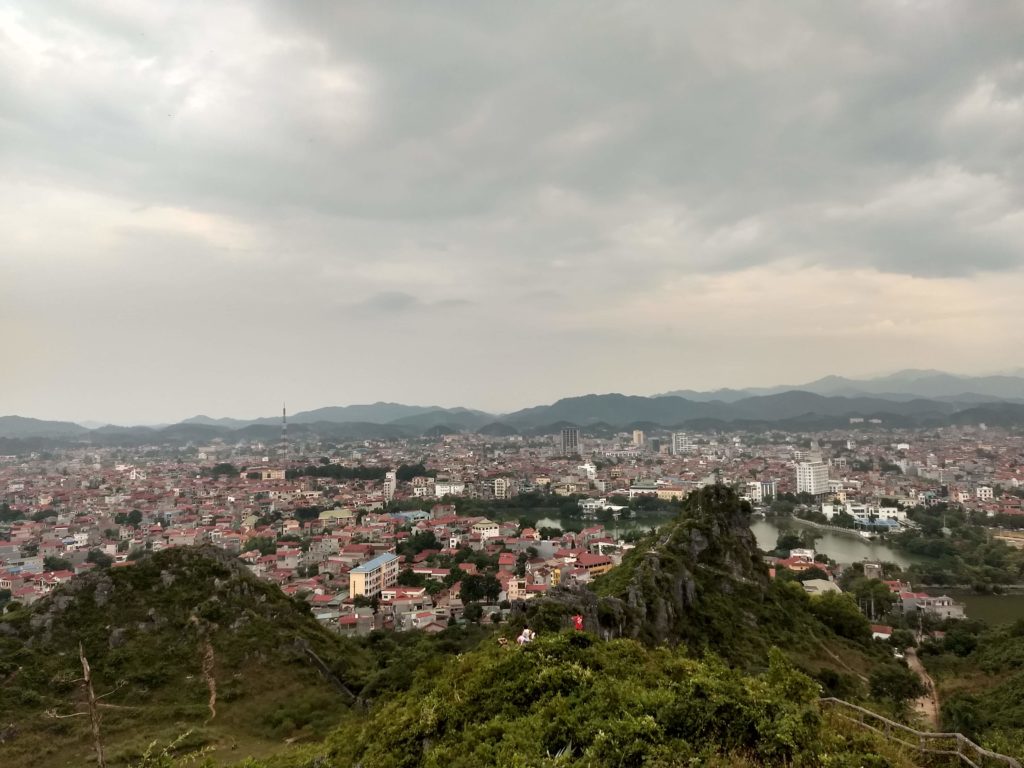

Ha Long Bay
Most tourists head to Ha Long Bay, yet it’s still not too crowded. In the town of Ha Long itself, there isn’t much to see. The new part of town, Bai Chay, accessed via the bridge, is full of tall, new luxury hotels waiting for crowds. You’ll also find several empty newly prepared beaches and a large ferris wheel on a hill in the city. The only way to reach the hilltop is via a cable car from the new district along the bridge. The whole thing isn’t cheap; if you’d like to walk or ride a motorcycle there, you won’t be allowed. You must take the paid cable car from the other side. Instead, though, you can hike up Bai Tho mountain, which is located right on the coast in the city.
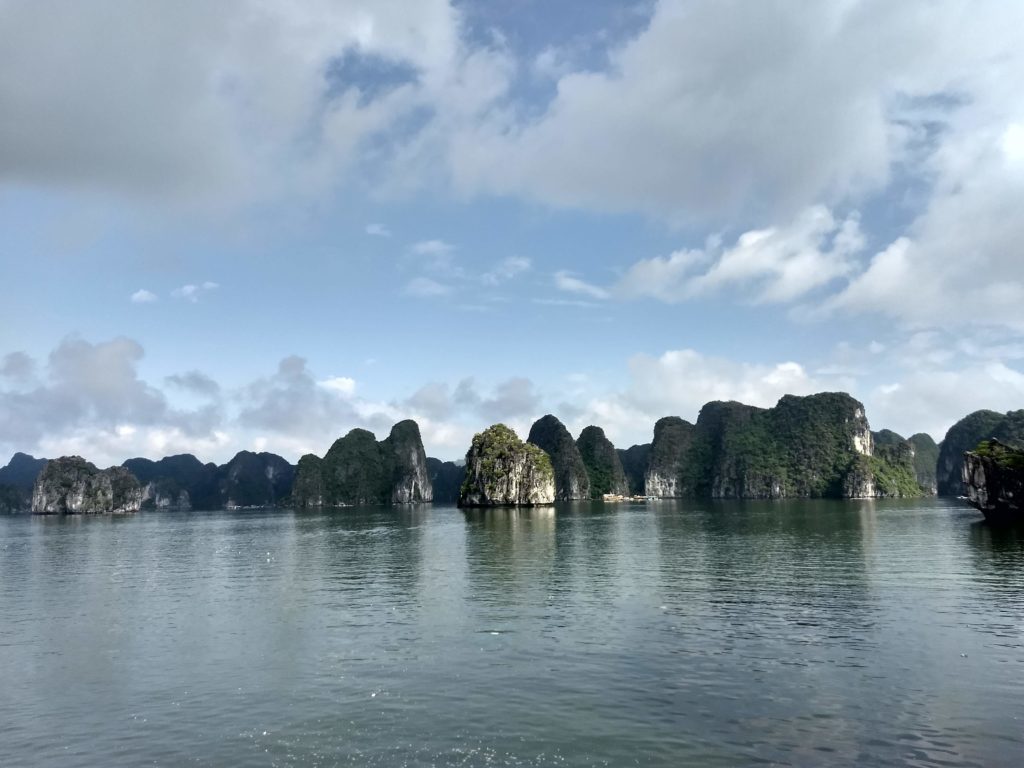

To discover the beauty of the renowned Ha Long Bay, you’ll need to take a boat trip through the bay. Essentially, you have two options: a day trip or a several-day cruise on a large boat with cabins that you book through a booking site or the individual company’s website. This is the more expensive option, amounting to several thousand crowns. The second, significantly cheaper option is a day trip on a smaller boat. You can easily arrange this trip on Cat Ba Island. There are plenty of sellers in the town and at the port offering essentially the same trip for different prices. You can also inquire at your accommodation, as they often arrange these trips as well.
Prices start at 300 CZK per person, and the price includes a full-day sail through the bay, lunch, a swimming stop (sometimes snorkeling), kayaking into a hidden lagoon, a visit to Monkey Island, where you can enjoy a sandy beach, several monkeys, and a view of the bay. Along the way, you’ll see many interesting rock formations. Be prepared to encounter other tourists on other boats; unfortunately, you won’t be alone here. Still, this trip is worth it.
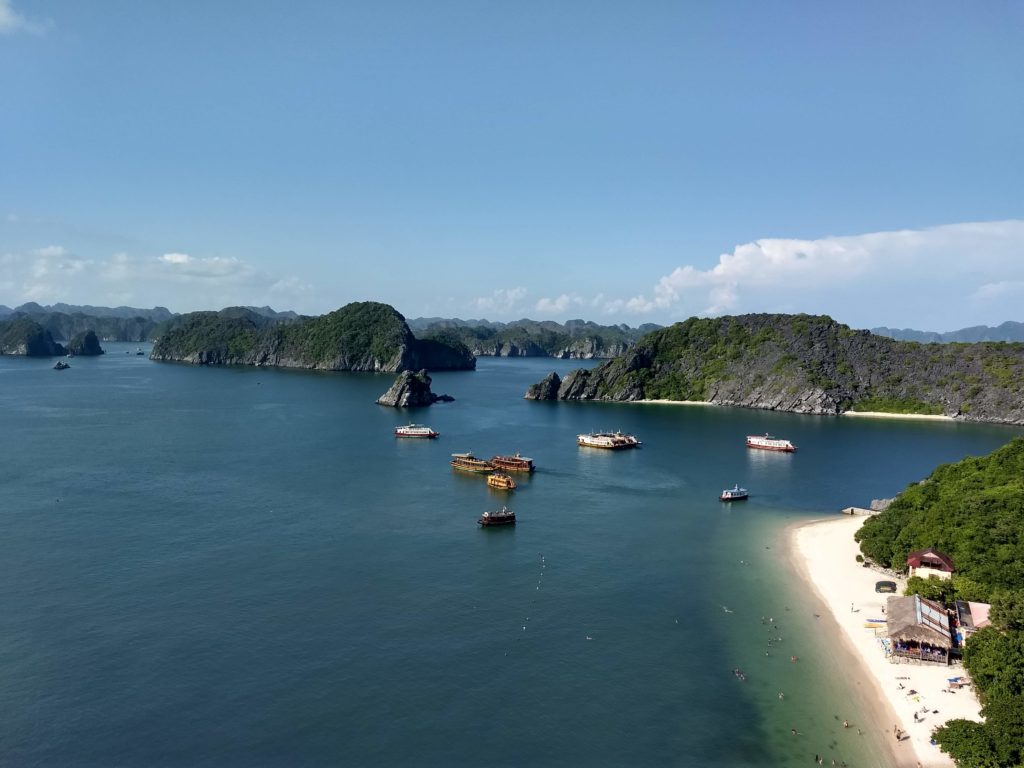

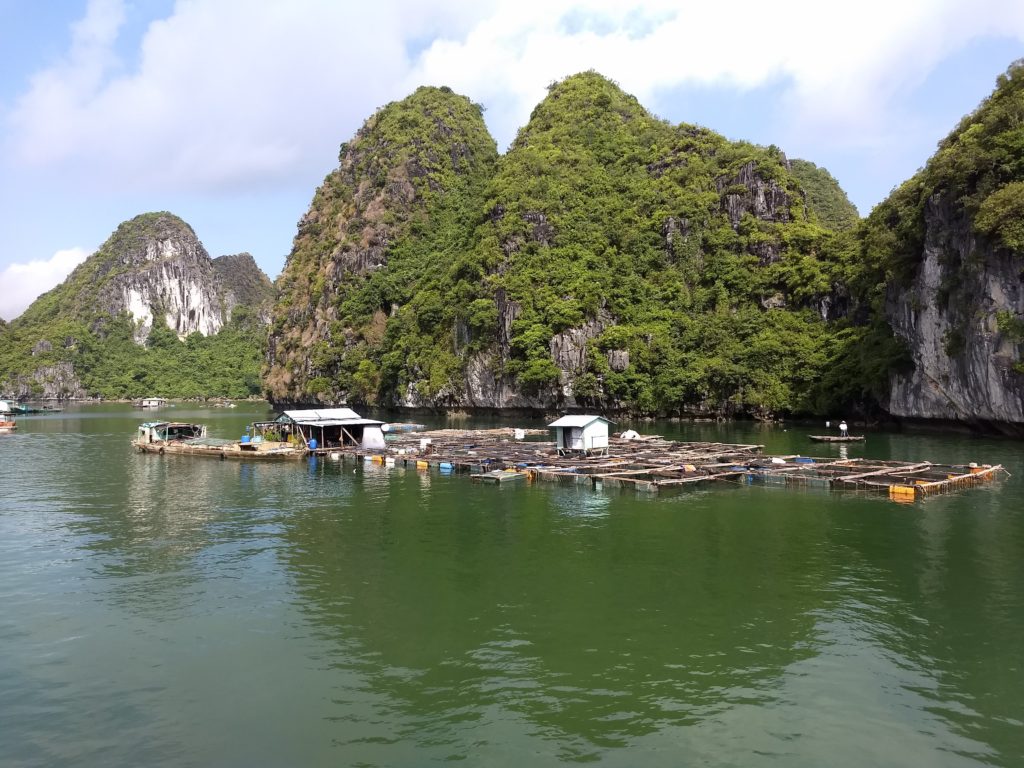

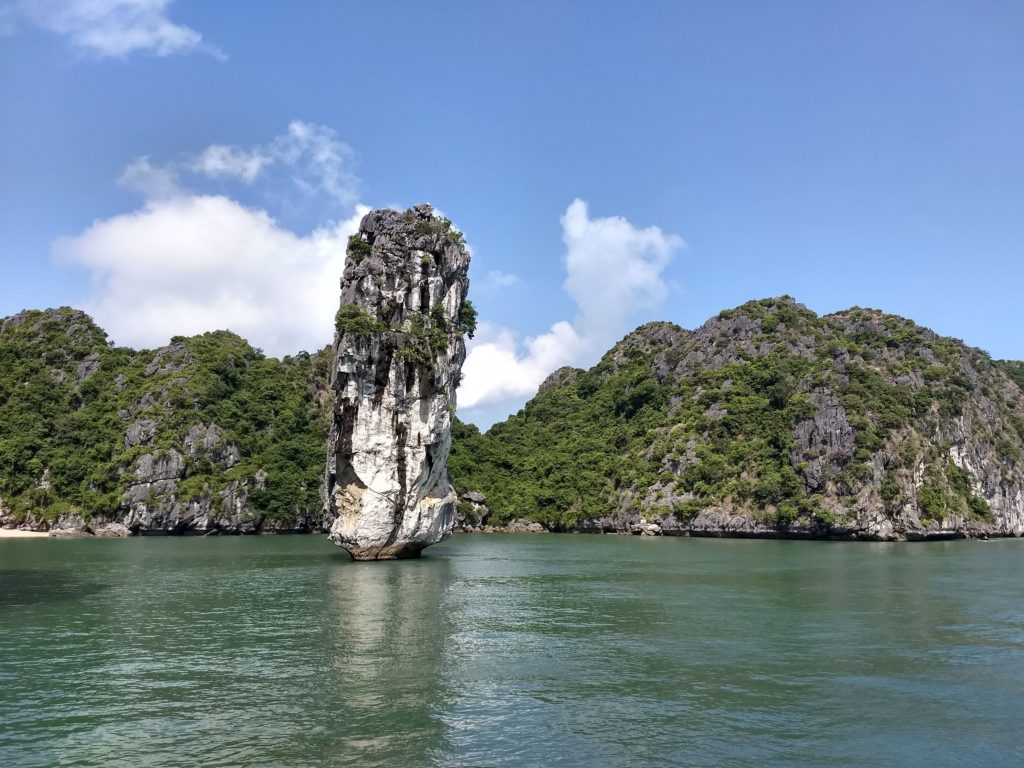

Cat Ba
Cat Ba is the largest island in the entire bay. You can get here comfortably by ferry with your motorcycle (which is handy on the island) from the new part of Ha Long from Dao Tuan Chau, which is connected to the mainland by a bridge. The ferry runs 3 times a day back and forth, and you can buy a ticket directly at the port shortly before departure. Cat Ba is a beautiful island covered with dense jungle (a large part of the island is a national park) with beautiful views and beaches. You can visit a total of 3 official beaches here – not too large. You can also visit a military hospital in a cave (where you’ll see soldier mannequins, weapons, operating beds, and other props), the stalactite cave Trung Trang, and the national park with a beautiful jungle walk up to the summit of Ngu Lam (225m). You can use one ticket for these two places. All these places are located along the main road across the island.
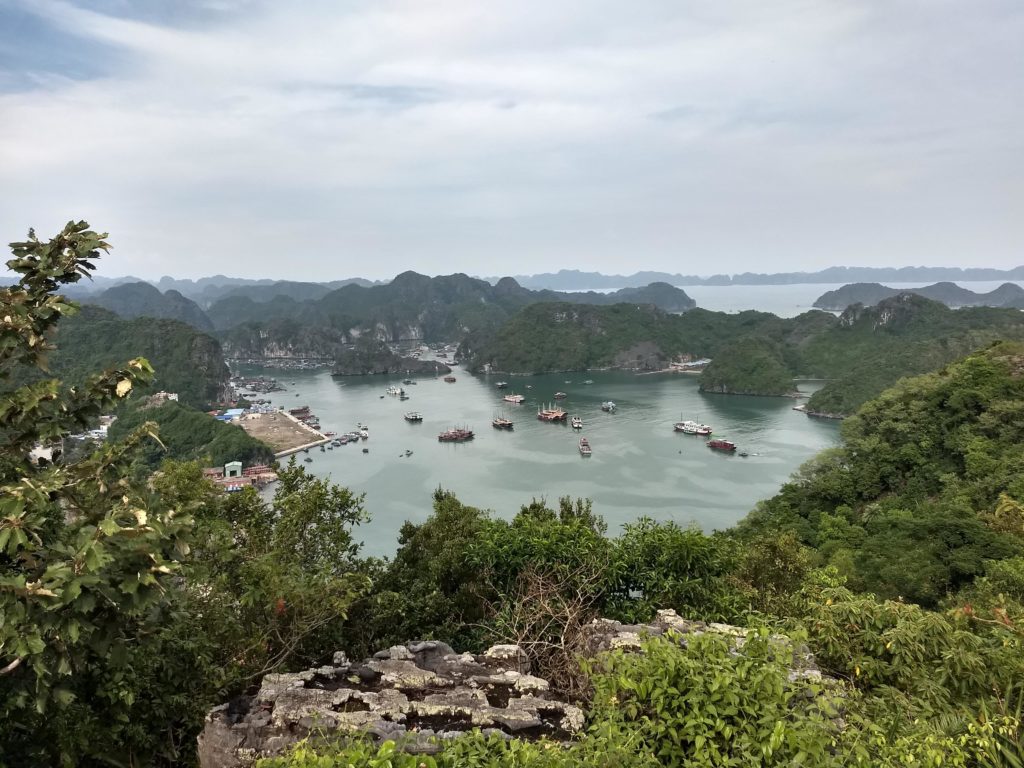

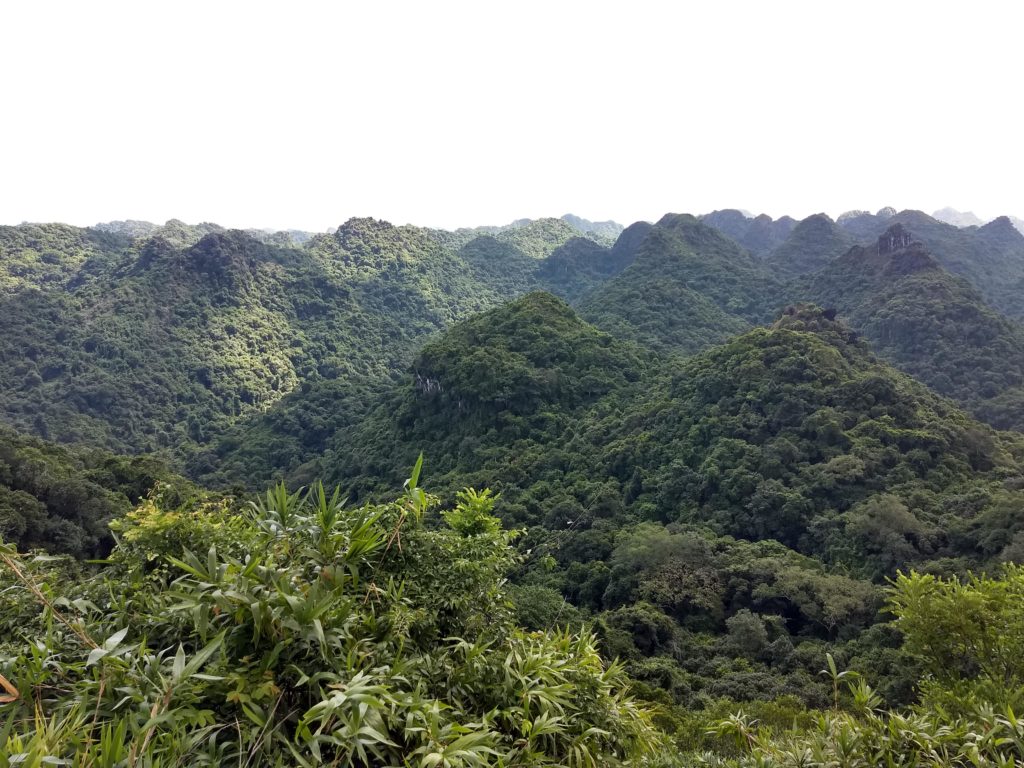

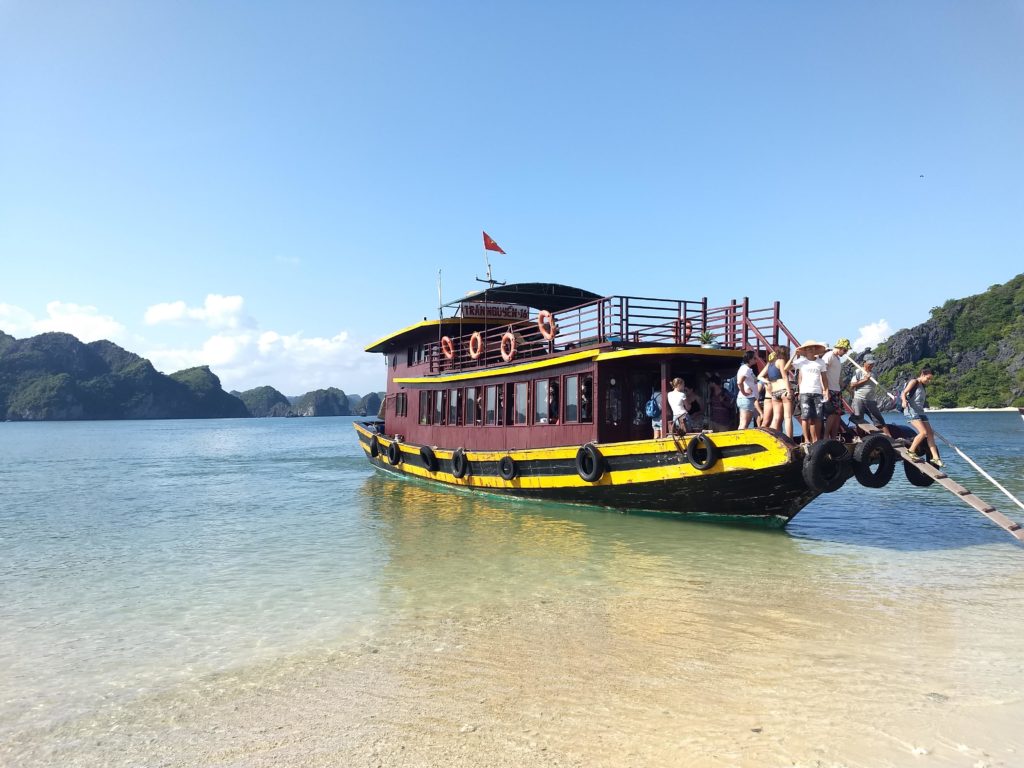

In the town of Cat Ba, you will find accommodation, restaurants, cafes, beaches, and viewpoints. From the port to the city (on the other side of the island about 22 km away), you can either take a taxi or a bus that connects to the ferry.
Central Vietnam
Hue
A historic royal city where you can learn about life here in the past. Hue was the capital during the Nguyen dynasty until 1945. The city is crossed by the Song Huong River, on which you can sail on historic boats with a dragon symbol. Along the river, tour vendors offer boat rides to the gate of the imperial citadel.
Imperial City (Hue Imperial City)
The historic center of the city where the emperor lived. During the war, this city was practically destroyed, with only 20 buildings remaining out of the original 148. The city is undergoing constant reconstruction, and some buildings are being restored. In front of the citadel is the flag tower, with a flagpole and a large flag – here, you will find the entrance gate. You can enter the citadel, after paying the entrance fee, through the Meridian Gate, which previously served as the entrance to the city. Only the emperor could pass through the central doors, his servants and family through the side ones, and the army and horses through the extreme ones. If you go straight ahead, you’ll reach the original forbidden city. Only the emperor, his wives, and concubines were allowed in this part. Even his son was expelled after reaching puberty.
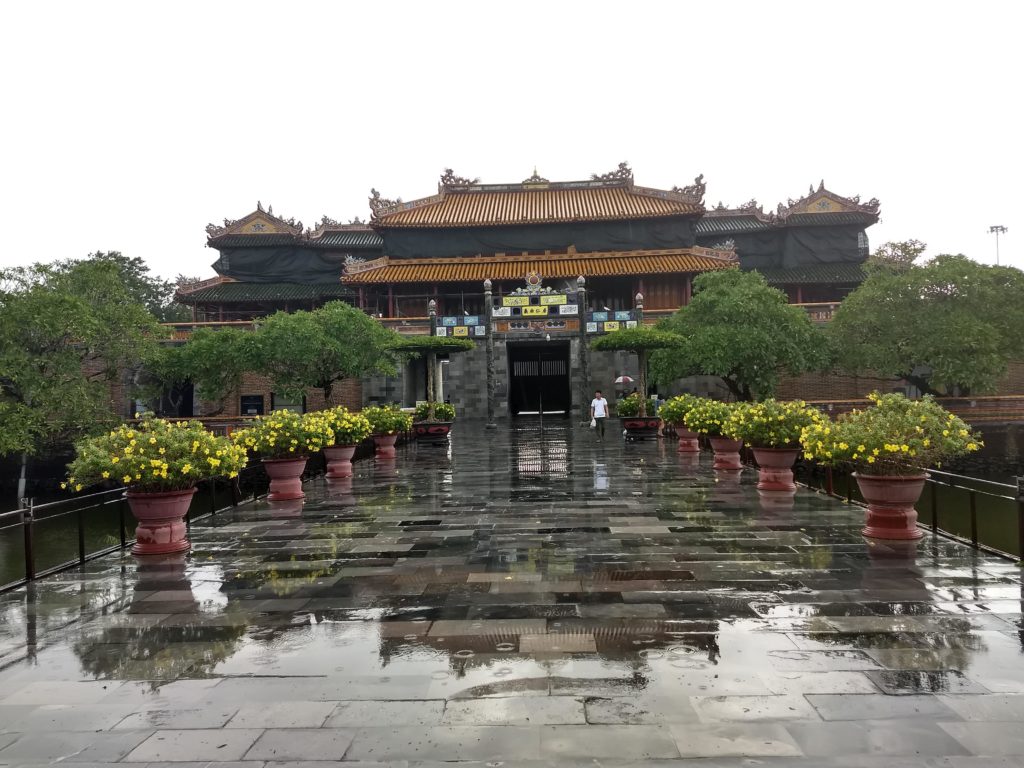

If you head west, you’ll reach a building where former emperors are buried – their exposed urns are on display. Each has their bed and items supposedly needed in the afterlife. Each emperor has their large bowl in front of this building, with Chinese characters describing their characteristics.
On this side, you’ll also find the women’s pavilion, where the last emperor’s wife spent her final moments.
Here you’ll also find various artifacts, photographs, document copies, and other items found here.
Hai Van Pass
The mountain pass between Hue and Da Nang is another famous attraction in central Vietnam. This pass was made famous by Top Gear in its special episode dedicated to Vietnam. Beautiful views, beaches, waterfalls, and stunning scenery await you here. In Hue, Da Nang, or Hoi An, you can rent a scooter and return it in one of these cities. The company renting you the scooter will provide you with a map of interesting places to visit along the way. Renting a scooter costs about 350,000 VND per day. As part of renting the scooter, the company also includes transporting your belongings to your hotel, so you don’t have to worry about luggage and can fully enjoy the trip. Or you can choose a much more expensive option with a guide in a group. The entire journey is about 130 km long, so it’s a day trip.
It’s important not to enter the relatively new tunnel near Lang Co Bay (from the north) but to go through the hills. The tunnel would deprive you of the views and the enjoyment of mountain switchbacks. Unfortunately, in the hills, you might encounter trucks since not everyone is willing to pay for the tunnel passage. Trucks can cause long traffic jams here if one skids and blocks the road. However, on a scooter, you’ll easily overtake the queue and continue on the open road.
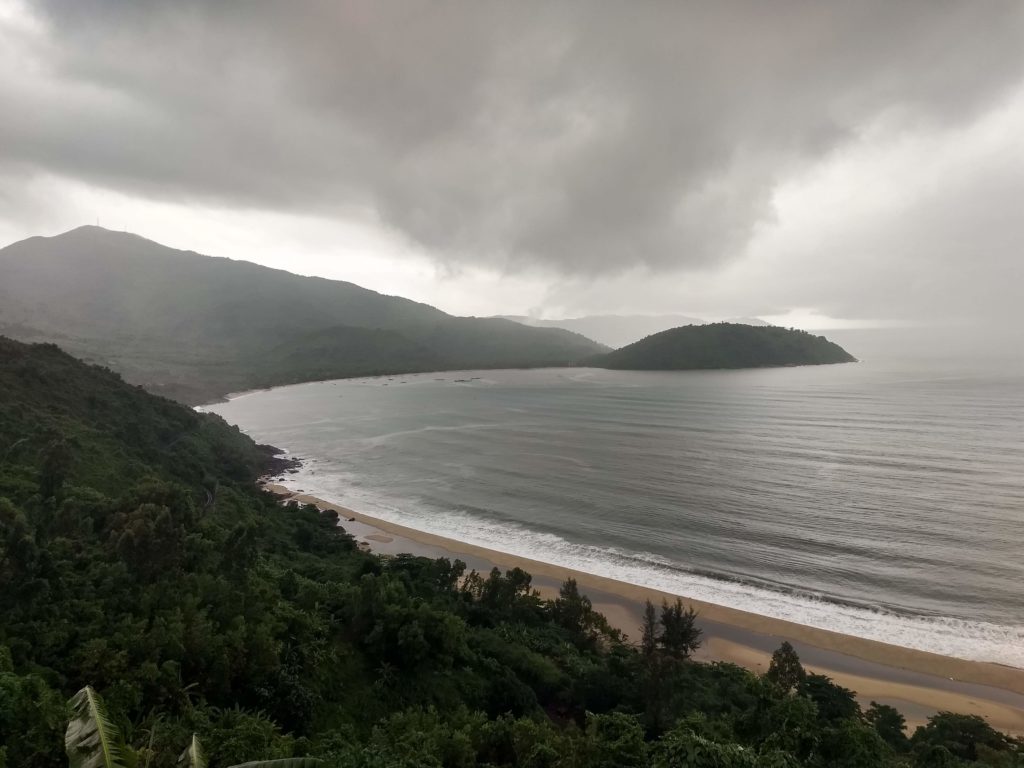

Da Nang
Da Nang is the third-largest city in Vietnam located on the coast. It’s home to one of the three international airports.
During the season, you can enjoy the tourist beaches here. Besides exploring the city, you can visit the relatively new Cau Thuan Phuoc bridge, from where you can see part of the city, or head to the Buddha statue Son Tra Guanyin. You can also hike up one of the Marble Mountains. There’s no shortage of bars, restaurants, and hotels here.
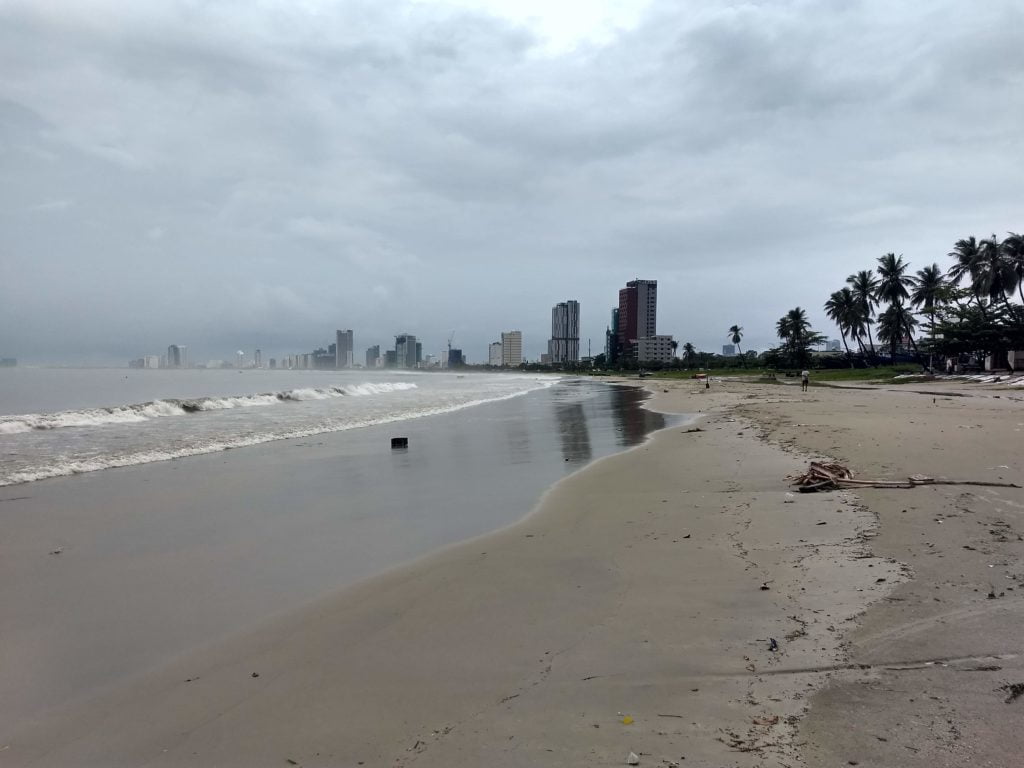

Marble Mountains
In the Danang area, you can visit the Marble Mountains, considered sacred by the locals. Each mountain bears its name according to the ancient Chinese theory—one representing the most important elements: Water, Wood, Fire, Earth, and Metal. The largest is the Water Mountain. They are more like hills in the city connected by staircases than mountains. You can reach the top by foot or elevator. As it’s a short and undemanding ascent, we recommend walking. At the top, you can climb several viewpoints offering beautiful city and coastal views. You can walk among temples and rocks, often hiding caves with more temples. There are refreshments and public toilets on-site (if they happen to be operational). The entrance fee for the mountains is reasonable. You can buy various marble products from locals around the hills, usually sculptures.
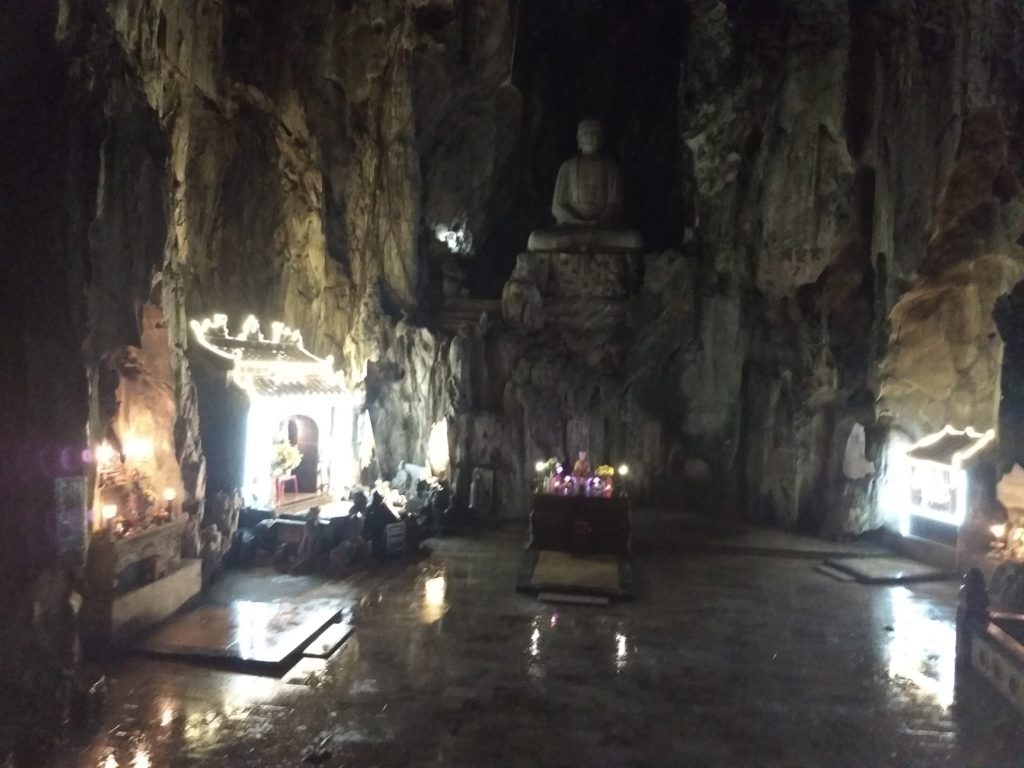

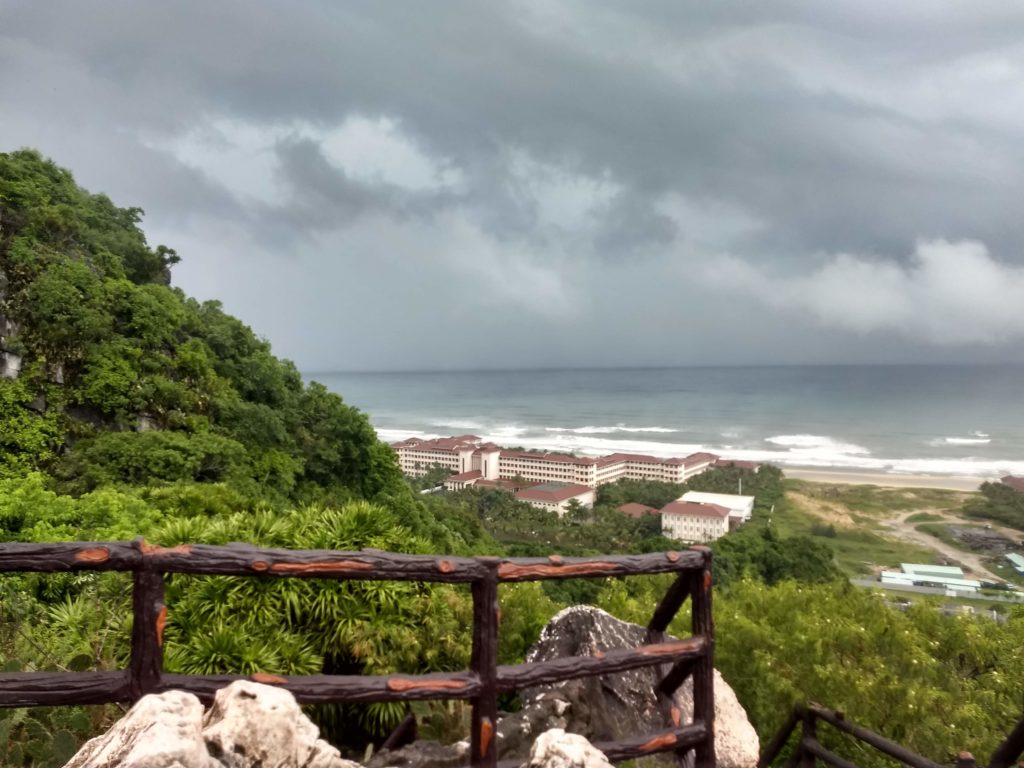

Hoi An
A beautiful historical town with a romantic atmosphere. It’s particularly famous for its shops and tailoring, where, for a low price (depends on the shop and distance from the center), you can have practically any piece of clothing made. From swimsuits, skirts, dresses, suits, coats to pajamas. Everything is made from quality material, and with a good tailor, they can make almost anything you request in a very short time. For instance, a suit or dress takes about 24 hours (we recommend booking 2 nights, as 2-3 fittings are needed before it fits perfectly), costing around $100-$200 depending on the material and the number of pieces, while a coat can be ready in 4-5 hours. This clothing is really high quality and very stylish, not the typical Vietnamese market clothes.
Almost everyone finds something here. Either you choose from a catalog, a ready-made piece on a mannequin, or show a picture from the internet and explain what you’d like. It’s financially more advantageous to visit tailors outside the old town. Here, you’ll get the same quality at half the price. If you plan to visit, don’t forget to leave space in your luggage or, of course, you can have it sent home by mail. However, sending a package is quite expensive, and you might need to collect it in Prague, paying taxes and customs duties.
The town has its old quarter filled with numerous shops, cafes, and restaurants. You’ll find two bridges here. One is the Japanese Bridge, very picturesque, and the other connects one of the islands to the old town. On the island, you can visit the night market. This entire area along the river between the old town and the island is beautiful after sunset. People release romantic lanterns into the river, and you can take a local boat ride or just stroll through the night city observing thousands of lanterns and lights. The city’s atmosphere at night is very romantic, but expect lots of tourists.
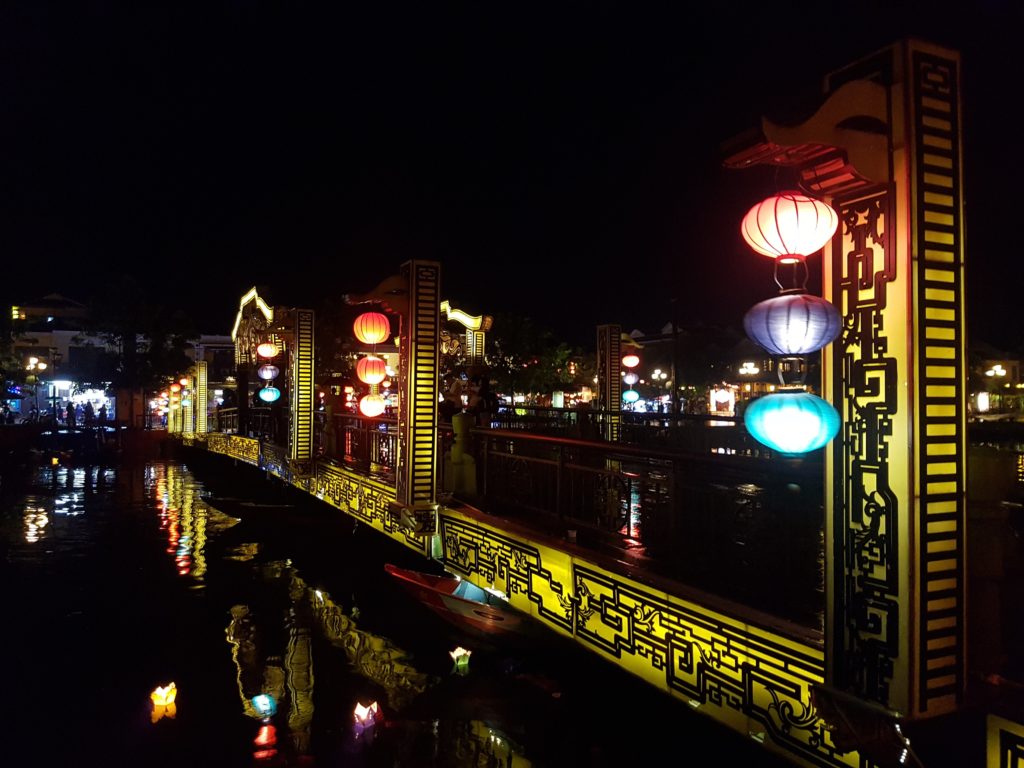

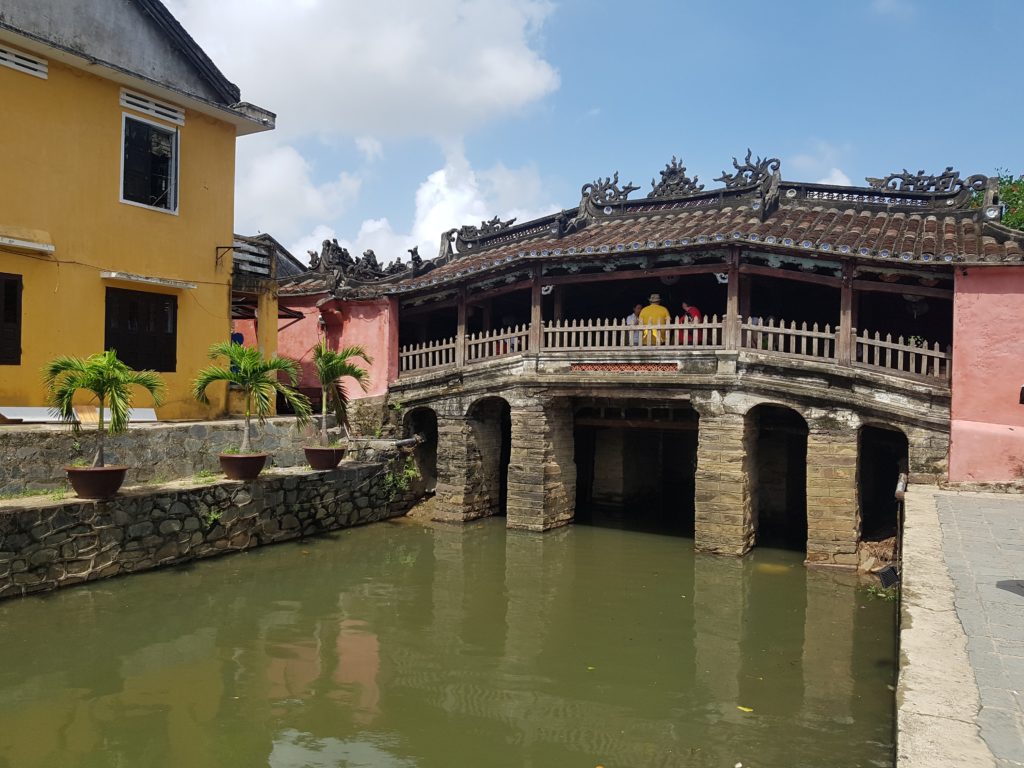

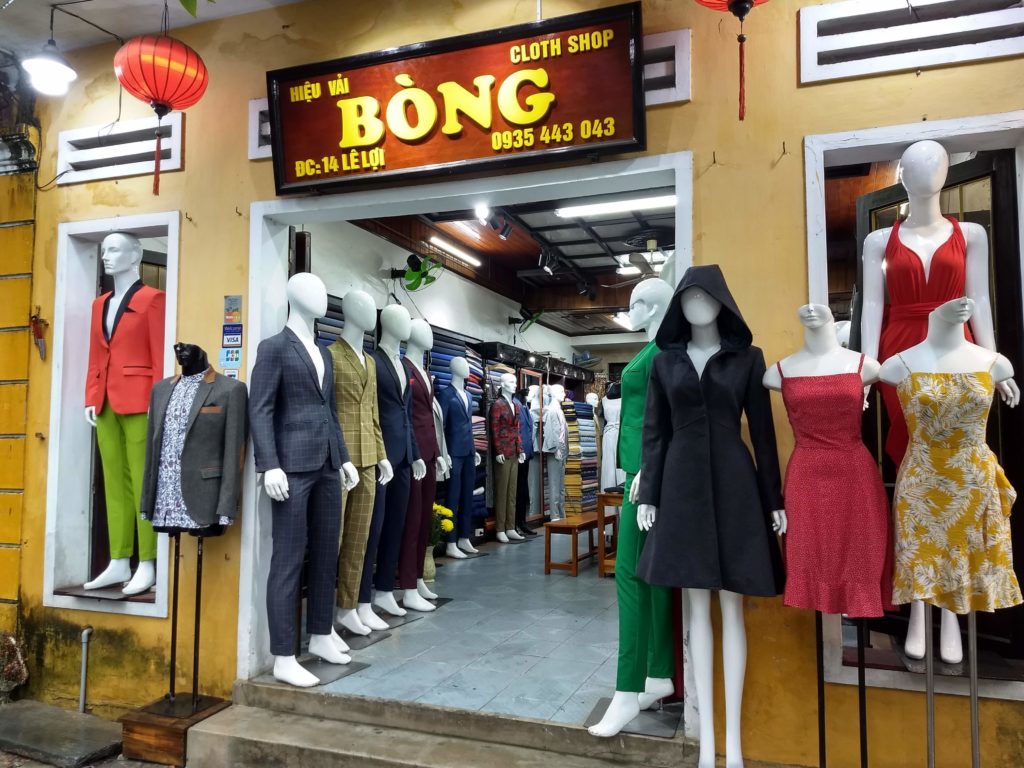

Southern Vietnam
Nha Trang
In Nha Trang, you’ll mainly find sandy beaches, water sports, bars, restaurants, and a vibrant nightlife.
You can take a cable car from here to the nearby island Hon Tre, where an amusement center and a dolphinarium are located.
Da Lat
A mountain town with a cooler climate on the way from Nha Trang to Saigon. The city used to be French, so you can visit the French quarter and several churches.
Another attraction of the city is the so-called Crazy House. After paying the entrance fee (40,000 VND), you can walk through truly crazy buildings, paths across roofs, etc. At the moment, there are three buildings with hotel rooms, but they are still expanding. The attraction is more suitable for children.
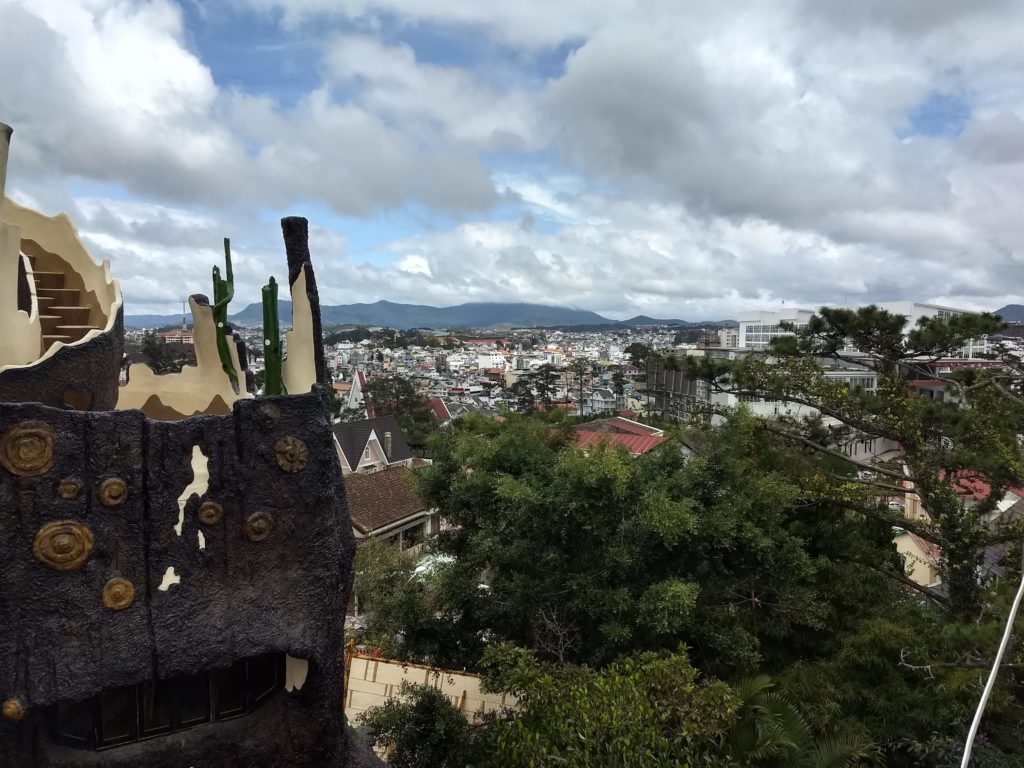

In Da Lat, it’s recommended to rent a scooter and explore nearby places. One of the places worth visiting is Lang Biang Mountain. Below the mountain is a parking lot where you leave the scooter for a small fee and pay the entrance fee to the park. Down at the parking lot, you can then pay for a 4×4 car to take you to the nearby hill with a view, but it won’t take you to Lang Biang itself, and you’ll have to walk half the way. From the parking lot, you can, of course, walk the entire way and not pay for the car. From the top of Lang Biang, you’ll have beautiful views of the surroundings if you’re lucky and there’s no fog. If you want to avoid parking and entrance fees, take the path that leads right next to the entrance gate (alongside) to the right. Drive a bit, leave the scooter somewhere, perhaps at a restaurant, and then walk uphill through the coffee plantations. You’ll see the summit from below.
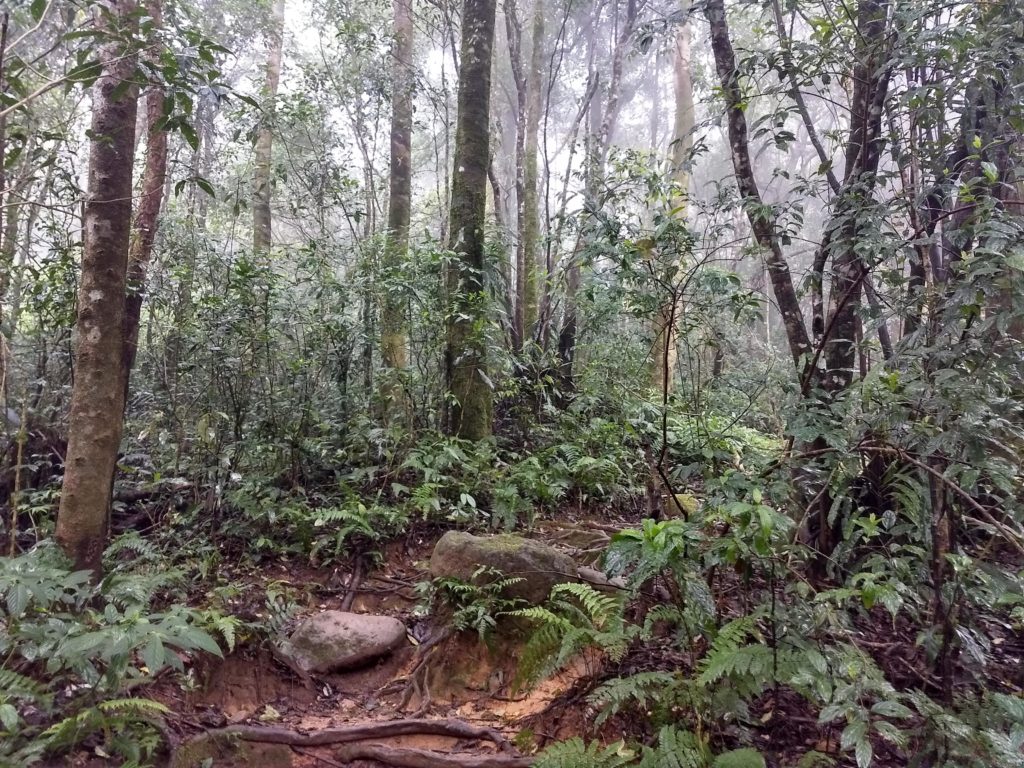

To the south of Da Lat, visit the tea and coffee plantations in Cau Dat (Cau Dat Tea Hill) near the village of Phát Chi. You can freely walk among the tea bushes and have a cup of tea or coffee. No entrance fees or parking fees.
Also worth a visit is the Elephant Waterfall near the village of Nam Ban. It’s a very easily accessible, mighty waterfall almost within the city. When entering, you pay an entrance fee and parking. During the rainy season, the waterfall is swollen and dirty. Next to the waterfall is a temple, next to which is a tall statue of Lady Buddha. You can enter this statue through a side entrance and an internal staircase that takes you almost to the top. The view of the surroundings and the waterfall is possible only through small windows on the sides and from the rear of the statue. Entrance to the Buddhist area and the statue is free.
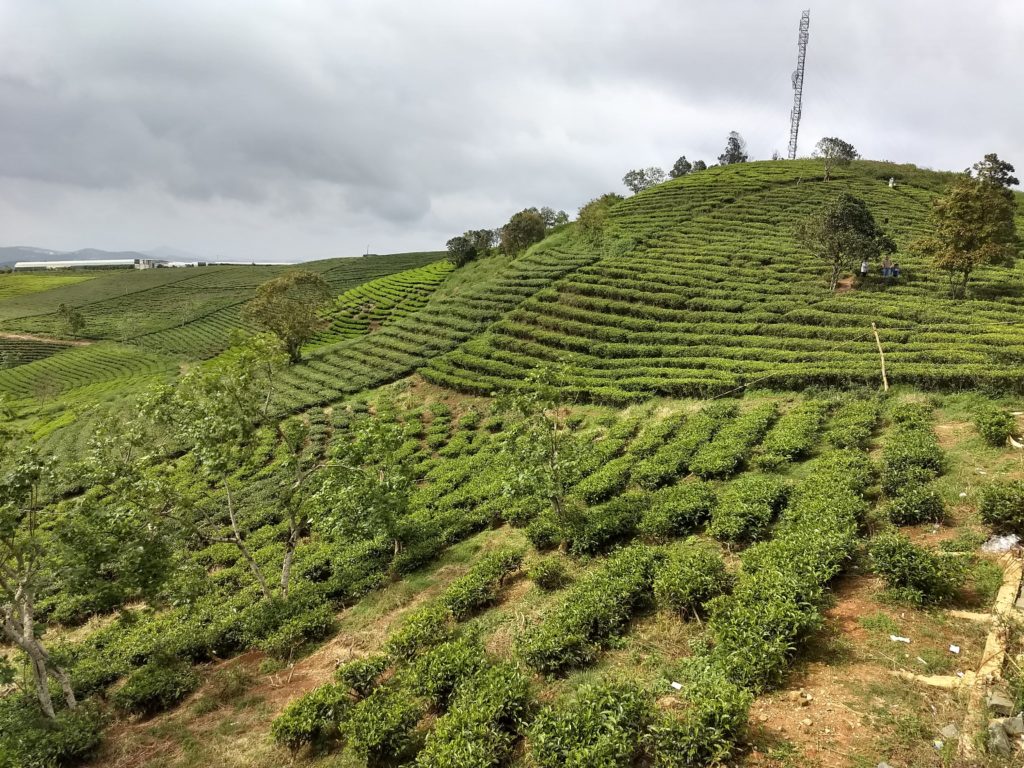

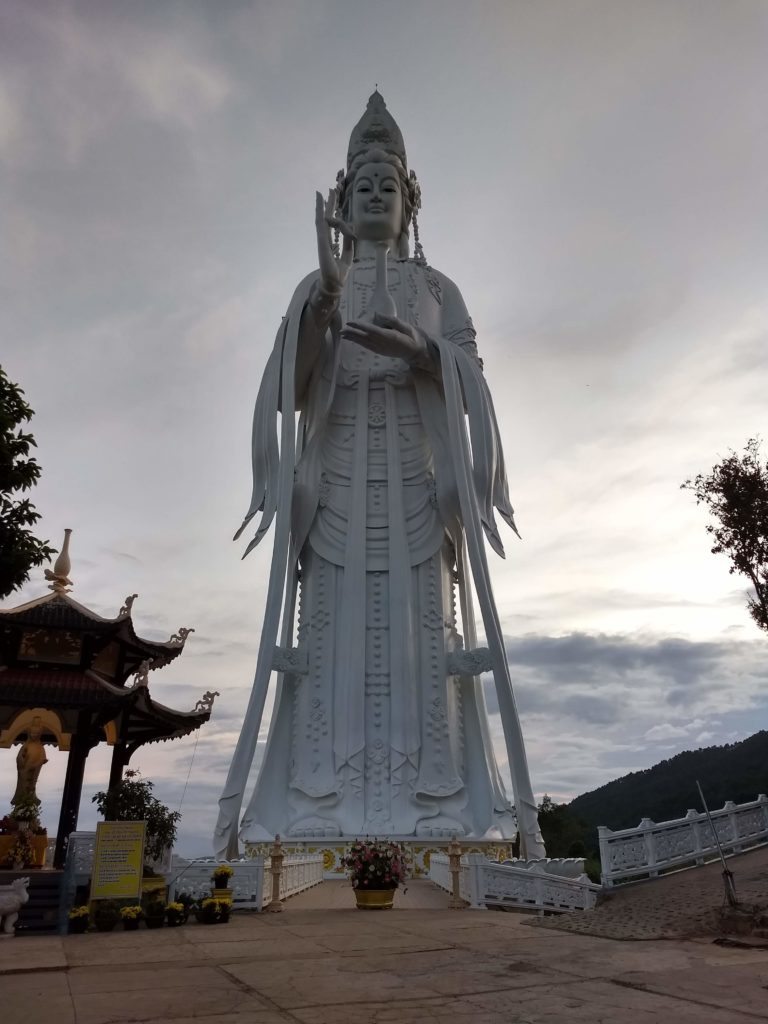

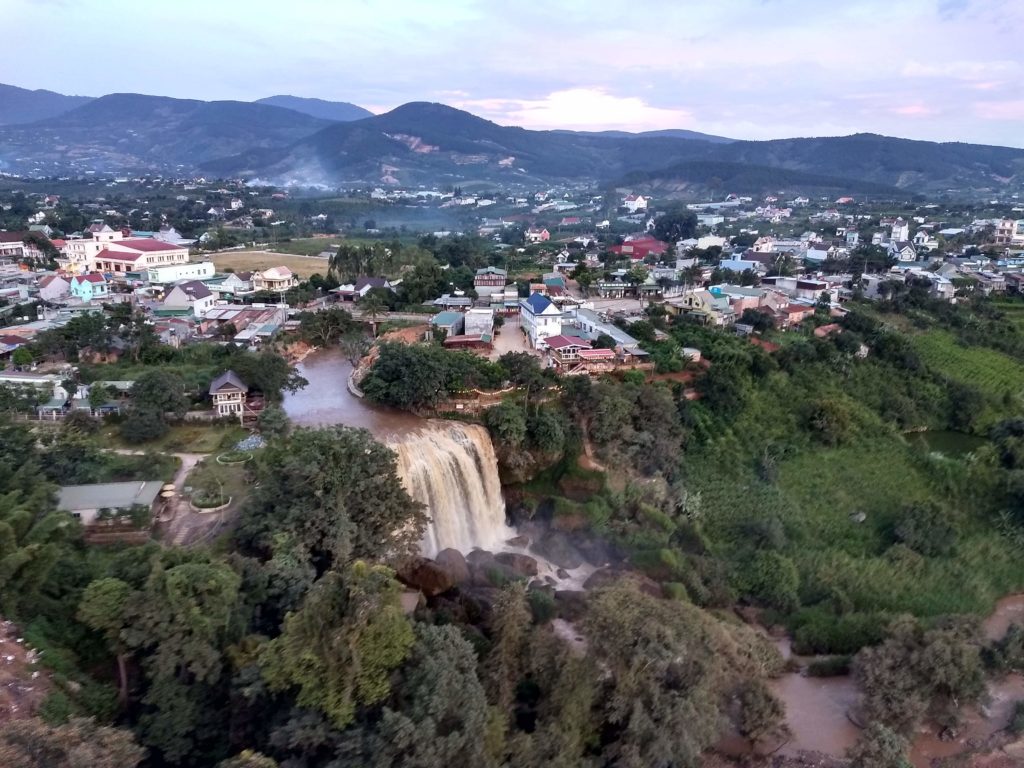

Mui Ne
If you have time left in Vietnam, you can also visit the huge sand dune near Mui Ne. Excursions are organized here from nearby towns and from Saigon. You can rent quad bikes here or just walk around the dunes.
Ho Chi Minh City (Saigon)
The capital of southern Vietnam, named after the national hero Ho Chi Minh. In the city, you can also find his museum. The city is large, but the center itself doesn’t offer as much. Saigon is a modern metropolis compared to Hanoi. You won’t find ancient houses with traditional shops here. Expect more of a supermarket or glass skyscraper.
In the city, you can visit, for example:
- French church Notre Dame
- Independence Palace, located near Notre Dame. For 40,000 VND, you can also go inside. Around the palace, there’s a nicely landscaped park with plenty of shade, ideal for resting.
- Vietnam War Museum, formerly known as the Museum of American War Crimes, which better describes what you’ll see inside. The museum displays the Vietnamese view of the war, how it progressed, what torture methods were used, what it caused to the local people and the landscape. Everything is very detailed and photos without any censorship are hung everywhere on the walls. In the pictures, you see corpses, severed hands and feet, bodies torn to pieces after a mine explosion. The effects of the Agent Orange chemical are also described in detail, where you’ll see photos of incredibly deformed children, including real human embryos in formalin. There are also detailed descriptions of the effects of Agent Orange, where you’ll see photos of incredibly deformed children, including real human embryos in formalin. There are also tanks, planes, and helicopters from the war. Strong hatred toward Americans is more than evident here.
- Sky Deck – The official name of the building is Bitexco Financial Tower. It’s one of the modern tall buildings in the center of Saigon. The upper floors serve as an observation deck overlooking the nine-million city and a sky-high cafe. The entrance fee to the viewpoint on the 48th floor is expensive even by European standards, but you can partially avoid it. If you enter the building from the side with freely accessible shops, take the escalator to the first floor. Right across from the stairs, you’ll see a person letting people into the elevator leading to the cafe. Simply say you’d like to have coffee upstairs, and you’ll get to the 50th-52nd floor without any problems or cost. The cafe is multi-story. Once seated, order your coffee or your favorite drink. If you’re not sitting by the window, wait a while, and as soon as a window seat becomes available, the waiters will come and move you there. Prices are really high for Vietnam, but an ordinary coffee (around 100,000 VND) still costs less than the entrance fee. We recommend arriving approximately 30 minutes before sunset, then during one visit, you’ll have a view of the daytime and nighttime city. However, don’t expect to be alone here at that time.
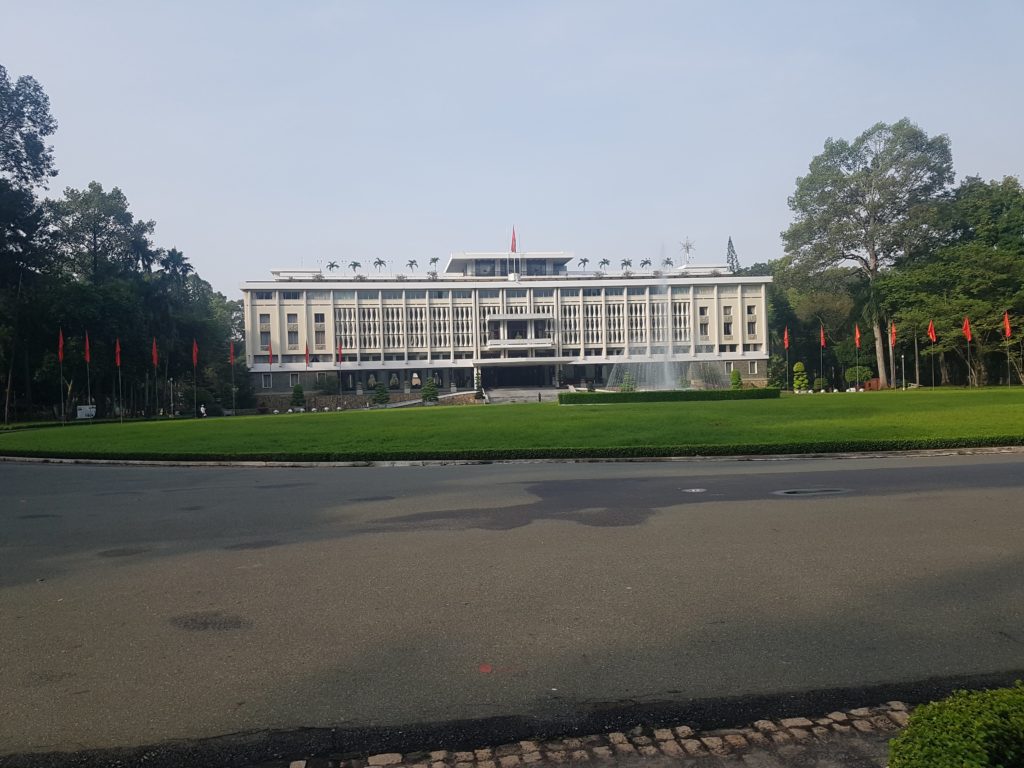

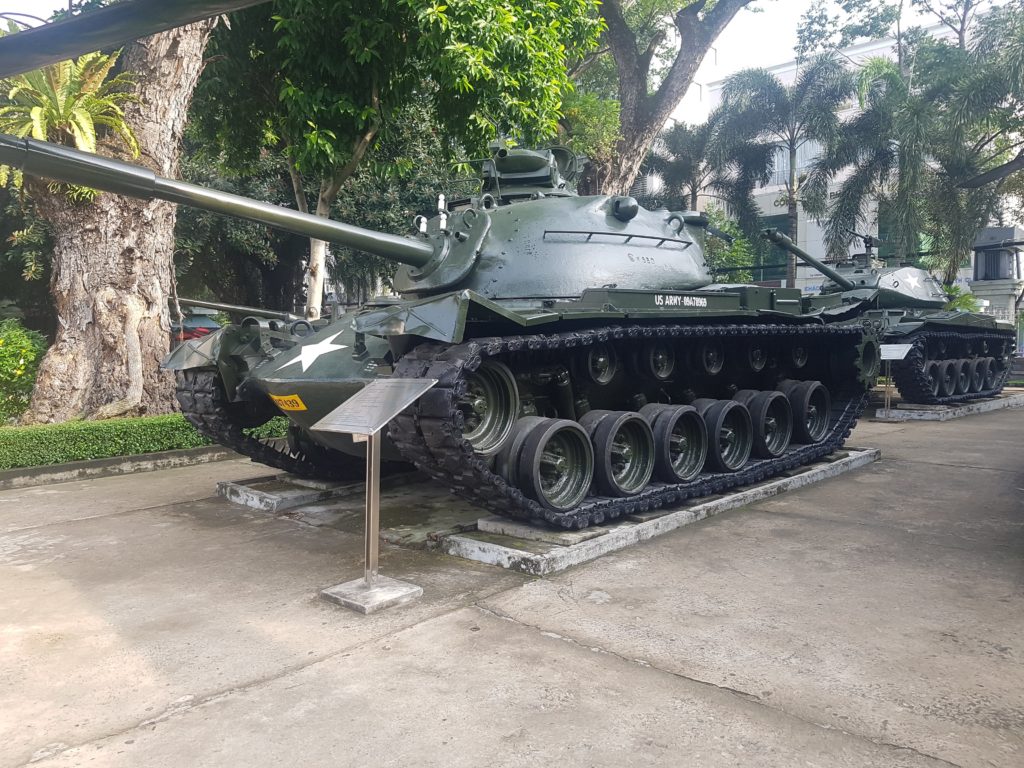

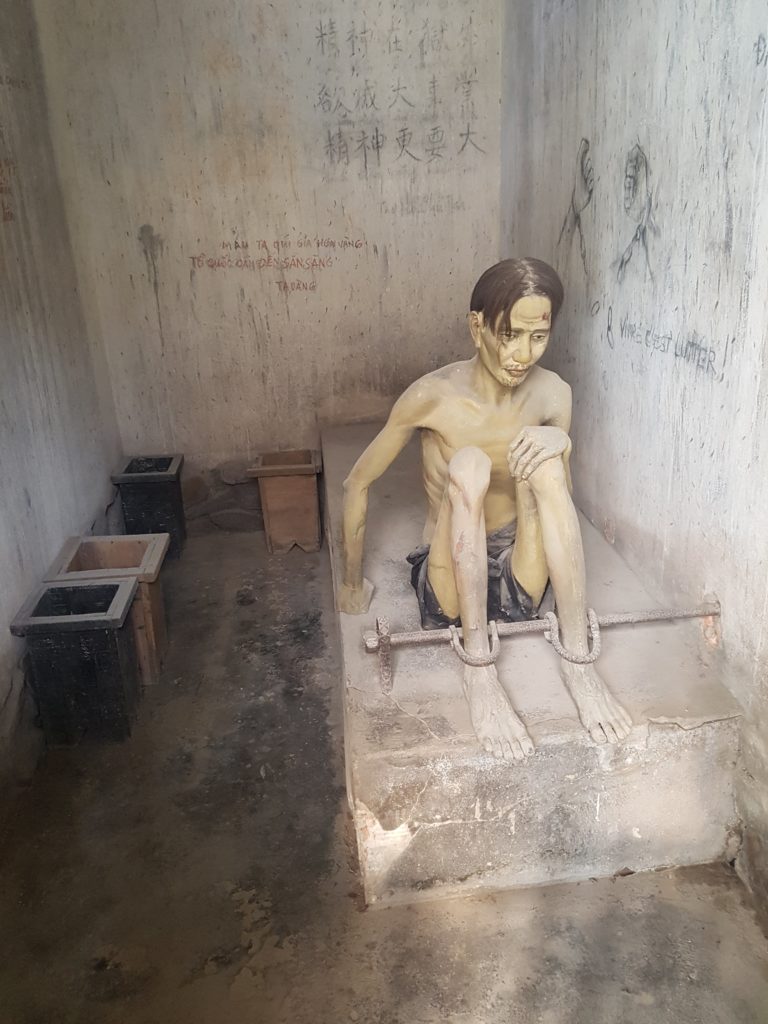

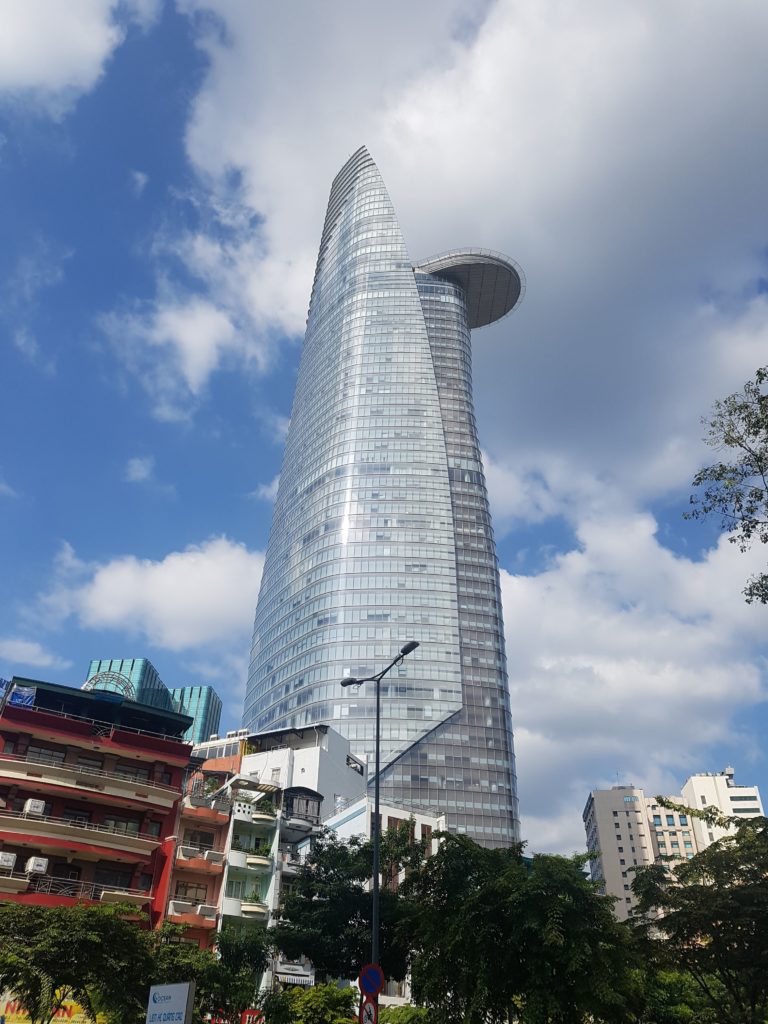

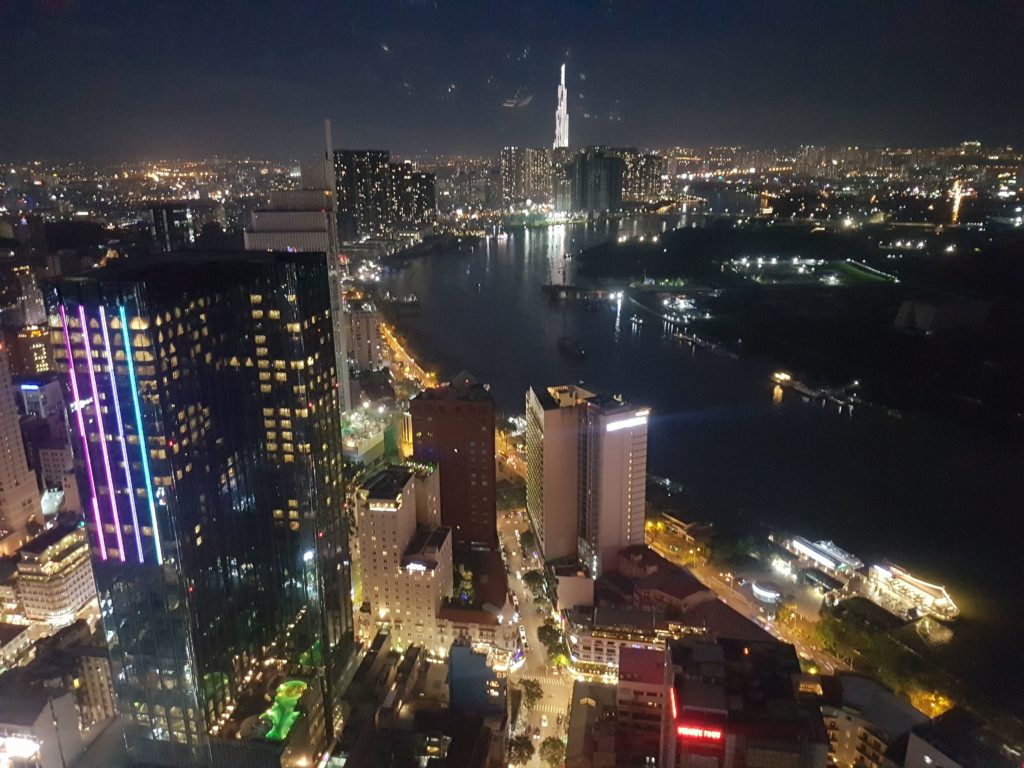

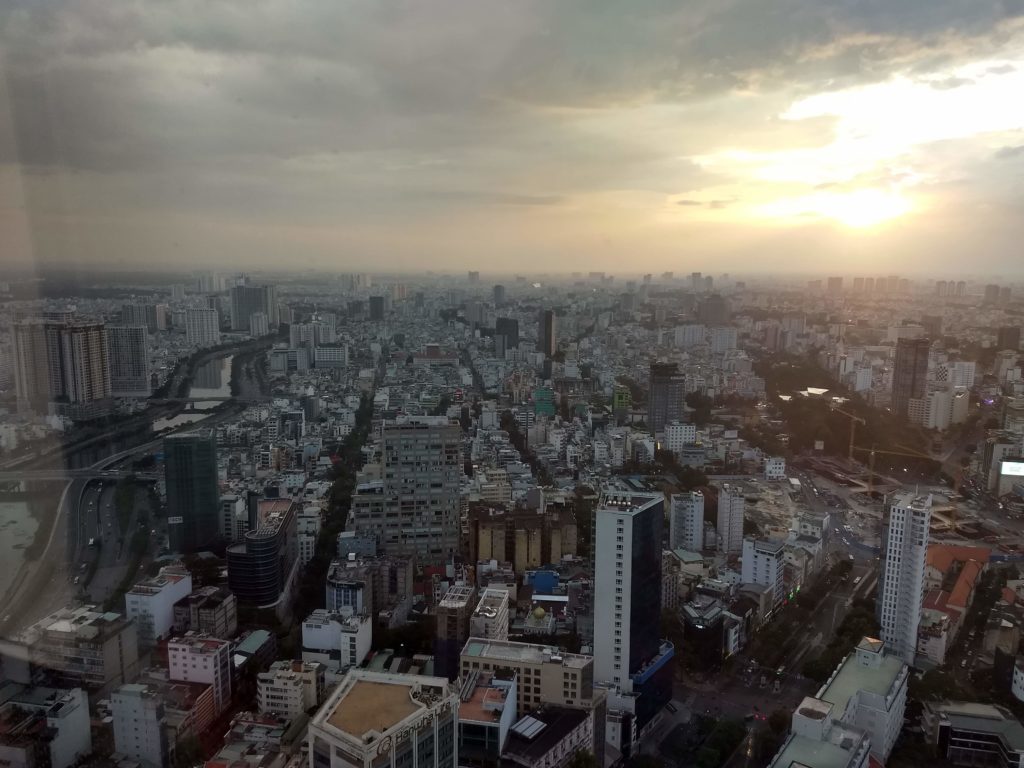

Mekong Delta
When traveling through southern Vietnam, don’t miss out on this extensive area. The highly diverse Mekong Delta spreads across an area as large as the Czech Republic and provides the main source of livelihood. Besides the network of rivers, streams, and various canals, you’ll also find several islands, towns, traditional villages, floating markets, fruit orchards, rice fields, and more here.
You can either explore the delta on your own or take advantage of multi-day tours offered by travel agencies in Saigon. The delta is enormous, and if you go on your own, you’ll need to plan everything, figure out where exactly to go, and also allocate more time. If you want to save yourself the hassle and time, go with one of the local tour companies. They’ll take you to many places that would be hard to find on your own and save you time. The price of the trip isn’t high – around 600,000 VND for a two-day trip with accommodation, lunch, breakfast, transportation, and tastings. However, the disadvantage of these trips is that all travel agencies go to the same places, so you’ll be crossing paths with other tours. You have the option to choose a one-day, two-day, or three-day variant. A very good choice is the middle ground, a two-day trip. Thanks to spending the night in the delta, you have the opportunity to visit the floating market and other places early in the morning. As part of the trip, you’ll probably visit these places:
My Tho
Vinh Trang Pagoda
One of the largest pagodas in the Mekong Delta. It was built at the end of the 19th century and is classified as a national and cultural monument. In the area, you will find several Buddha statues, each with its own meaning. The Sleeping Buddha represents peace and rest, the Happy Buddha represents contentment and joy, and so on.
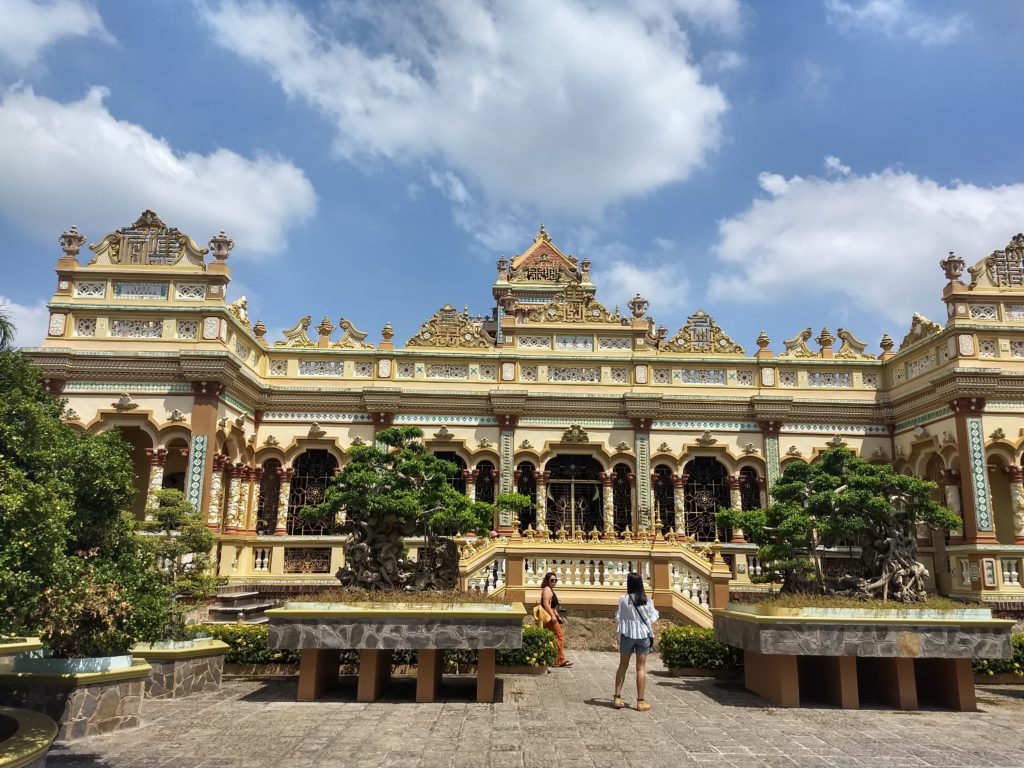

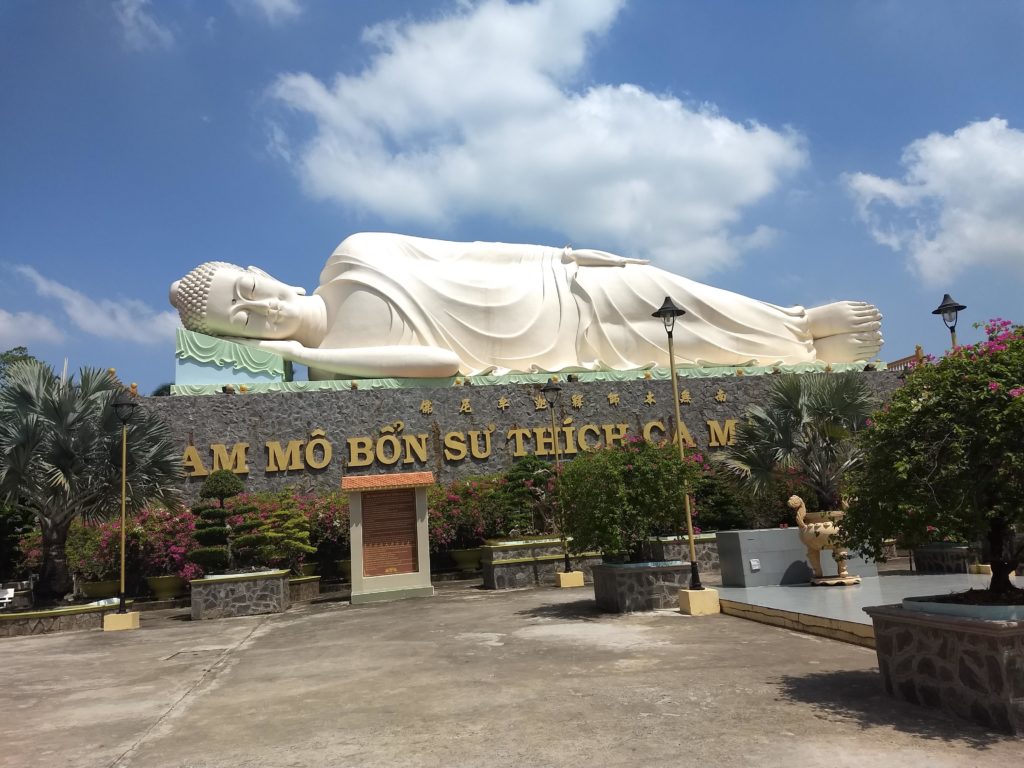

Four Islands on the Mekong River
Long, Thoi Son, Quy, Phung Islands. You can reach these islands more easily by boat. A bridge was recently built here, but it only connects two of the four islands. Before the bridge, it took an hour by boat to travel from one bank to the other; now, it’s just a few minutes across the bridge.
Thoi Son Island – is the most touristy island. Here, you can experience a ride on a typical boat through canals amidst banana trees and palms. Additionally, you can visit a coconut candy factory, a rice paper factory where you can try making rice paper and noodles, and as part of an organized tour, visit a crocodile farm in the delta.
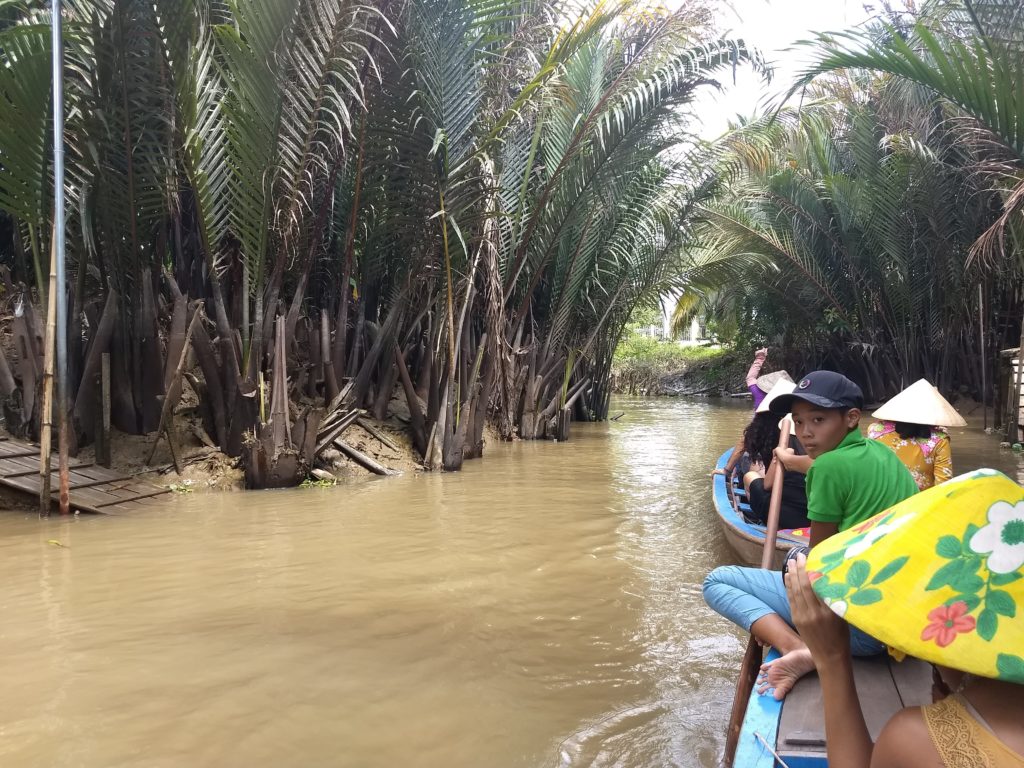

Can Tho
The largest city in the Mekong Delta is Can Tho. Here, you’ll find numerous fruit and vegetable shops, mainly along Hai Ba Trung Street heading south from the center. Everything comes from the fertile delta area, so you can expect low prices. In the city, there’s a pedestrian bridge that’s beautiful at night when lit, a riverside promenade where you can see a larger-than-life statue of Ho Chi Minh, a night market on Vo Van Tan Street with clothing, and another night market on Nguyen An Ninh Street mainly offering food.
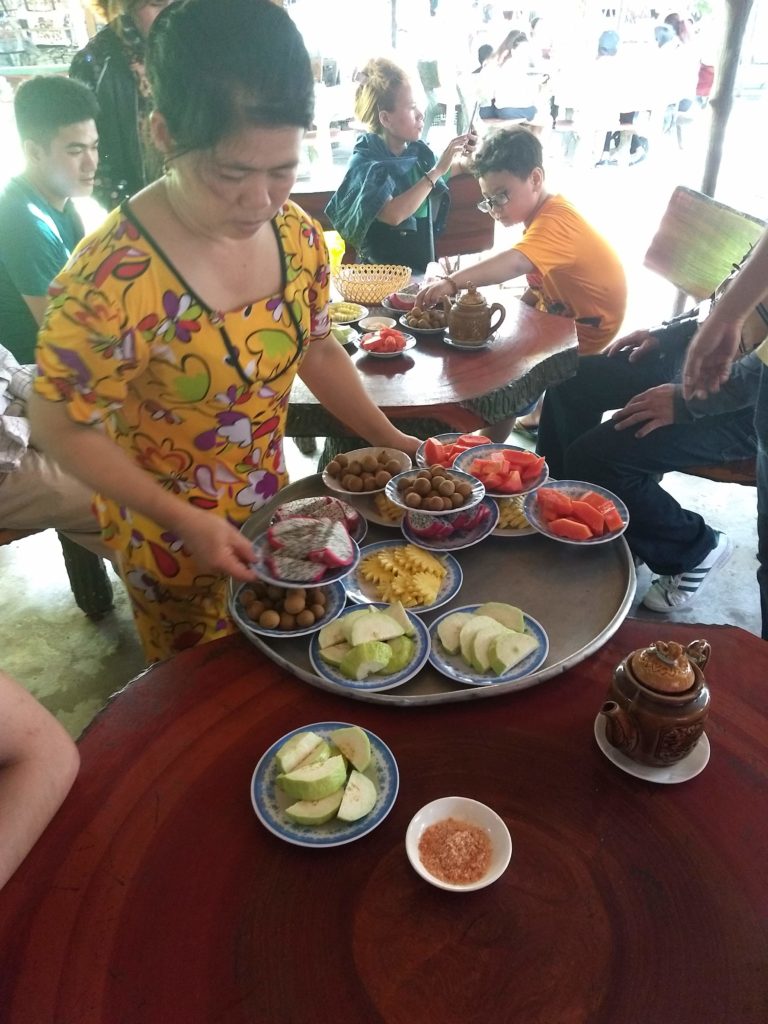

From Can Tho, tours set off to the so-called floating market.
Cai Rang Floating Market
You can’t reach these places on your motorbike, and you’ll have to rent a boat or join a tourist boat. You don’t have to worry about anything within the tour. Visiting the floating market is an interesting experience when sellers of fruits, vegetables, and sometimes other items stop by your boat to sell their goods directly from their boats to yours. They let you taste everything beforehand. Prices aren’t too high, even in this touristy area.
There are also larger boats parked where people come to shop. What they are selling is displayed – hung or impaled on a long stick, so even from a distance, you can identify the goods.
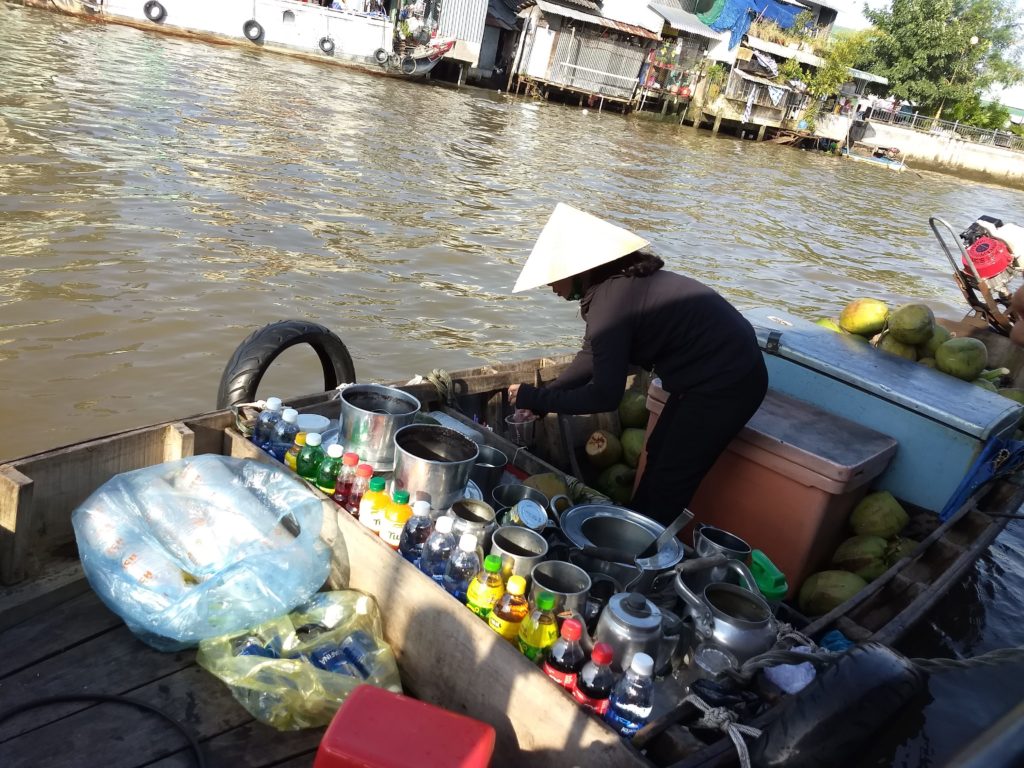

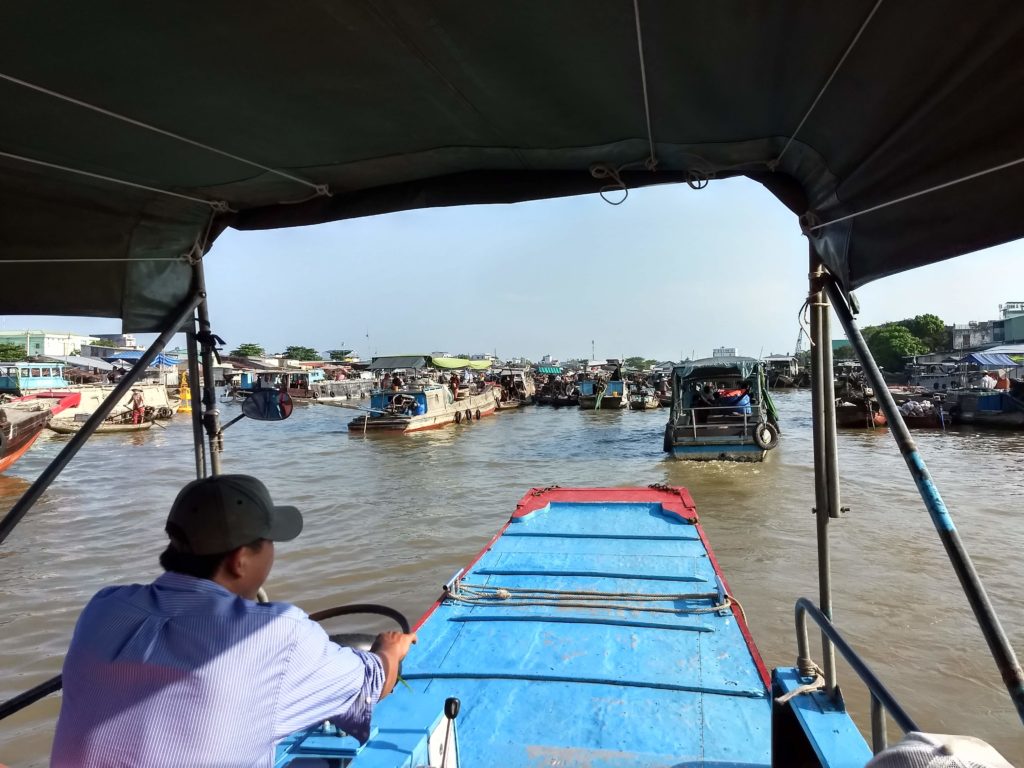

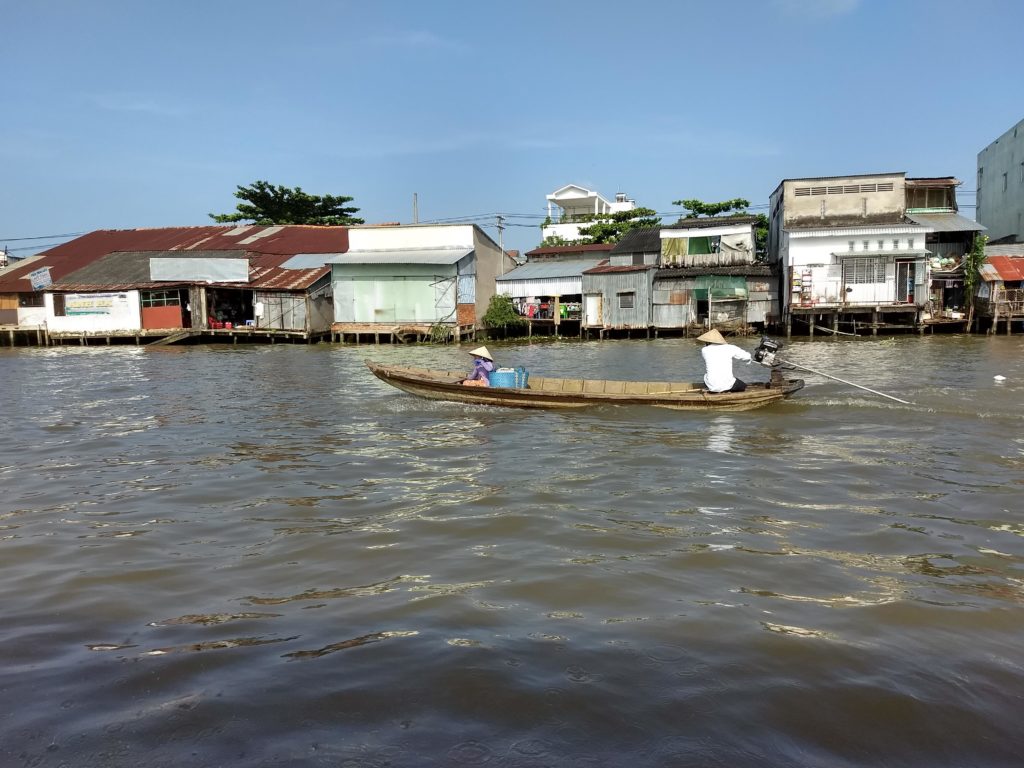

Několik zajímavostí na závěr
